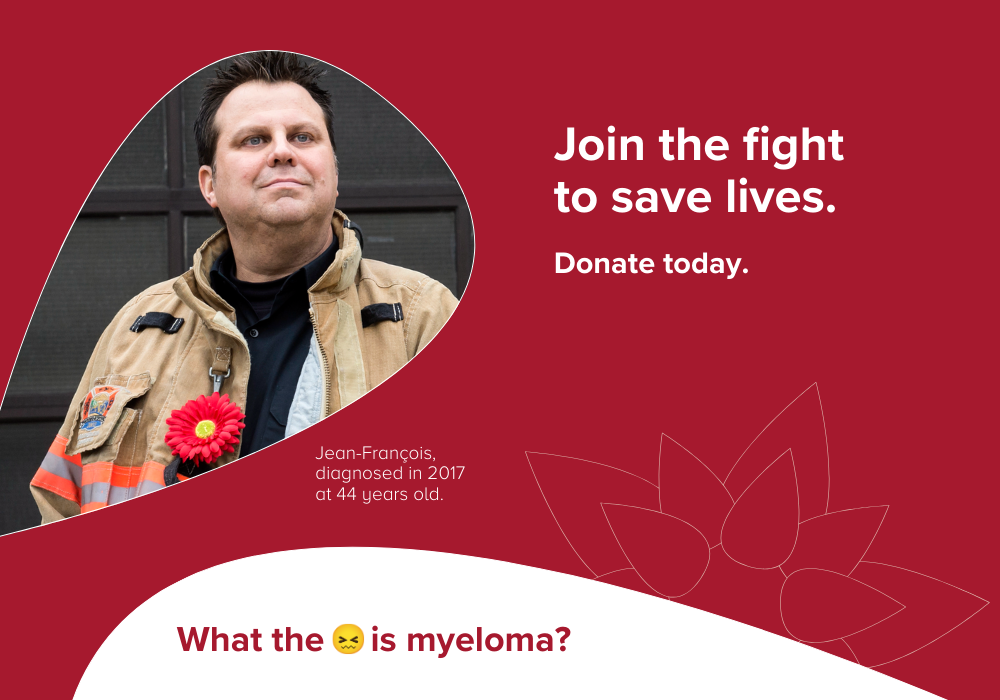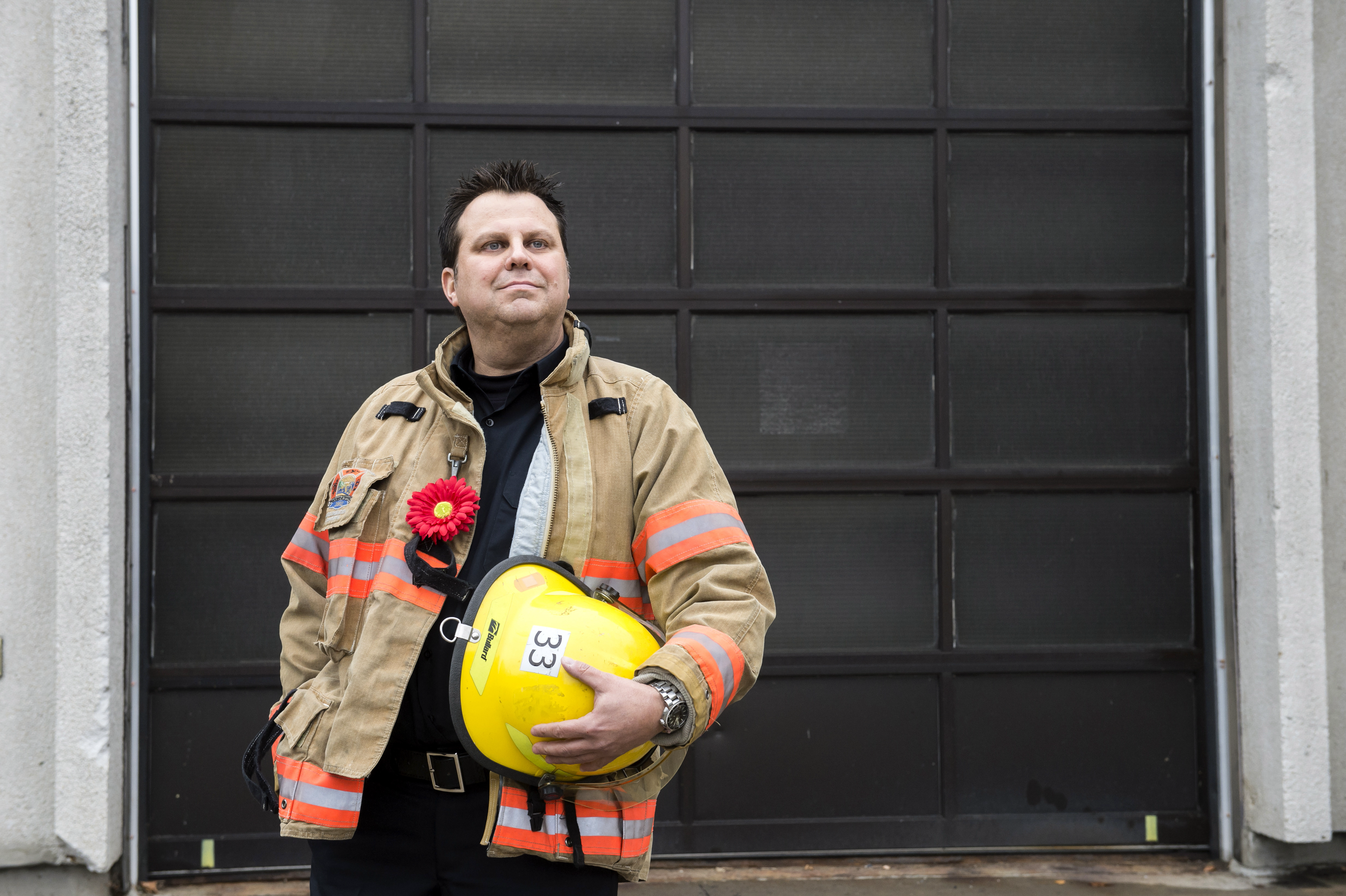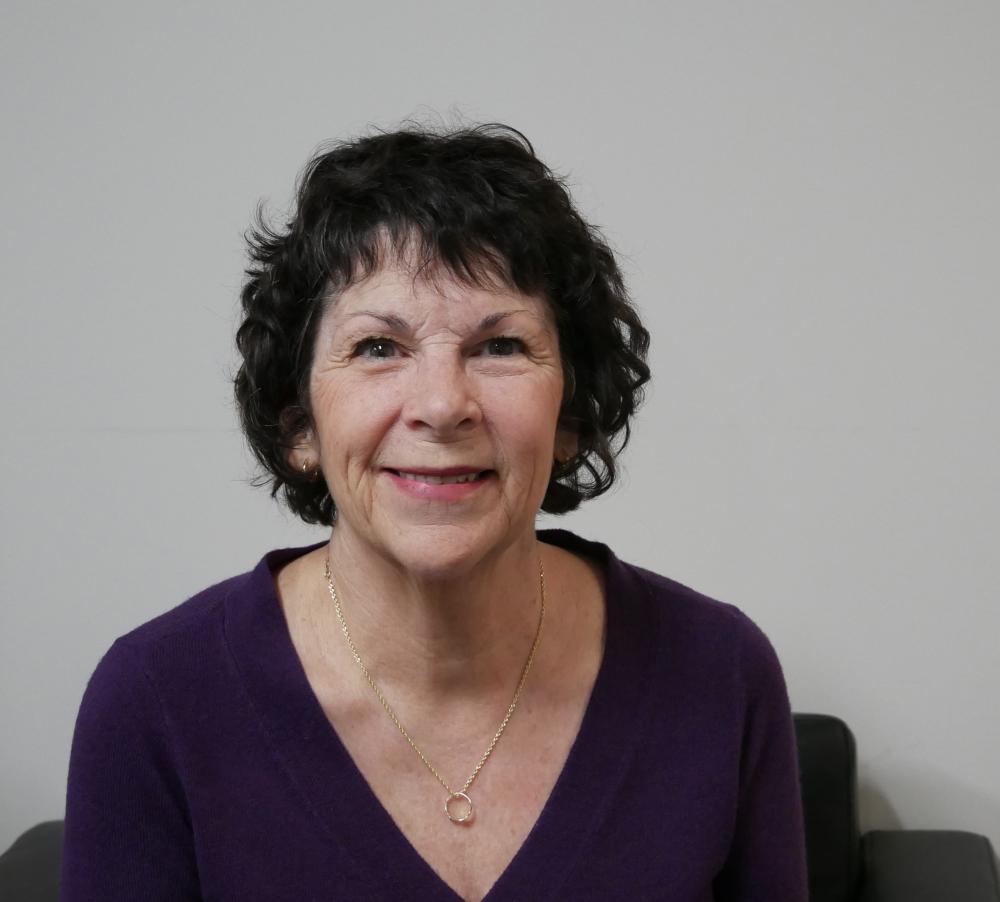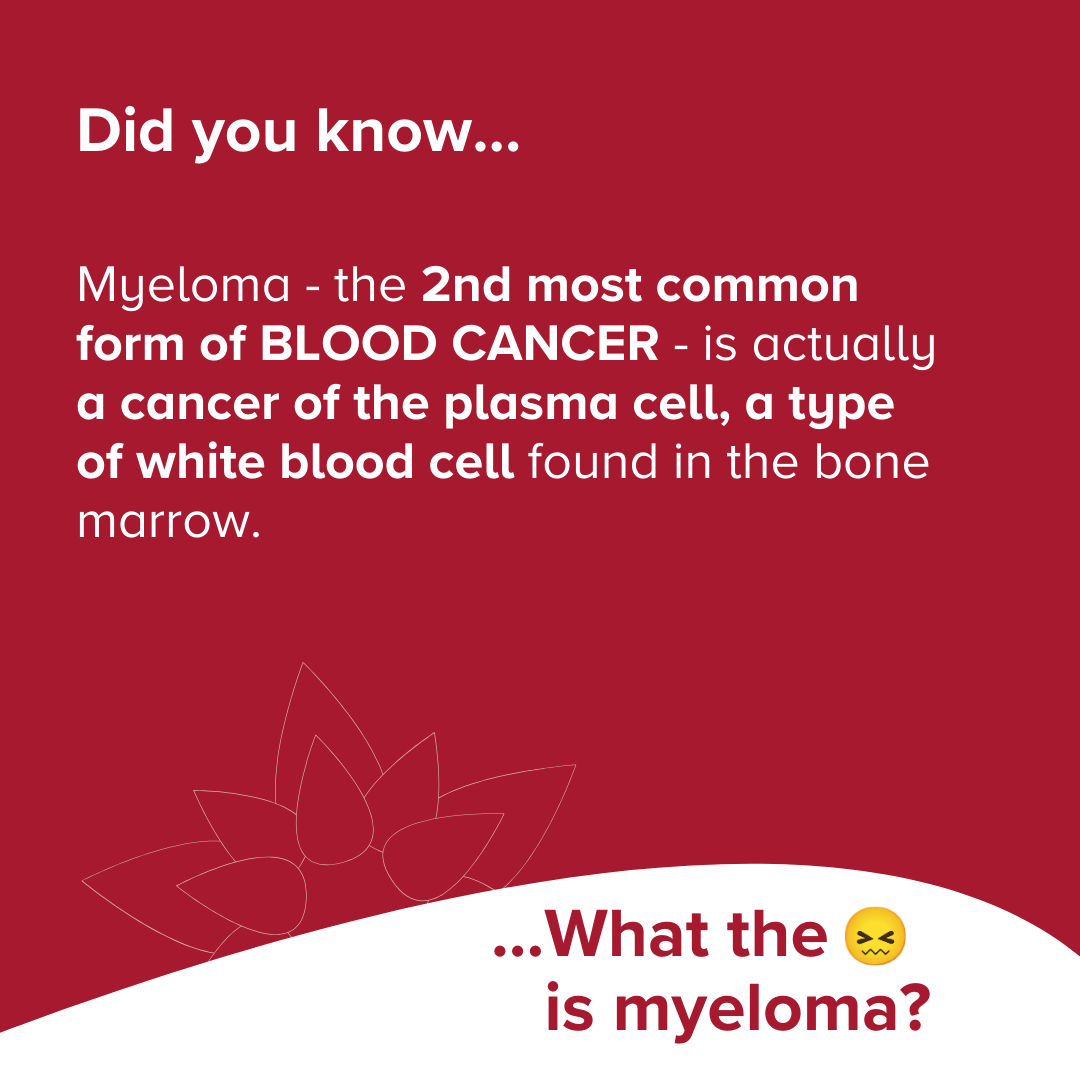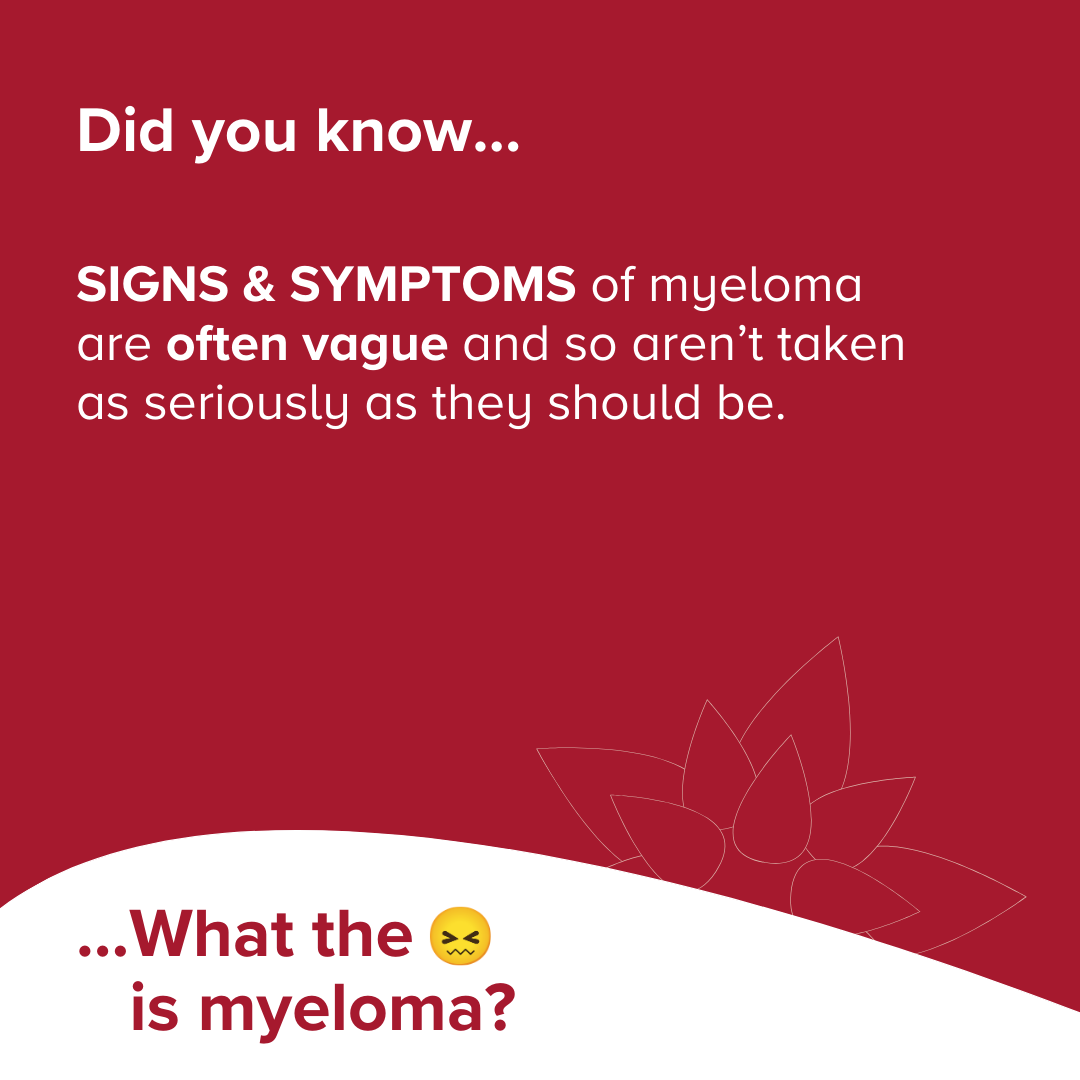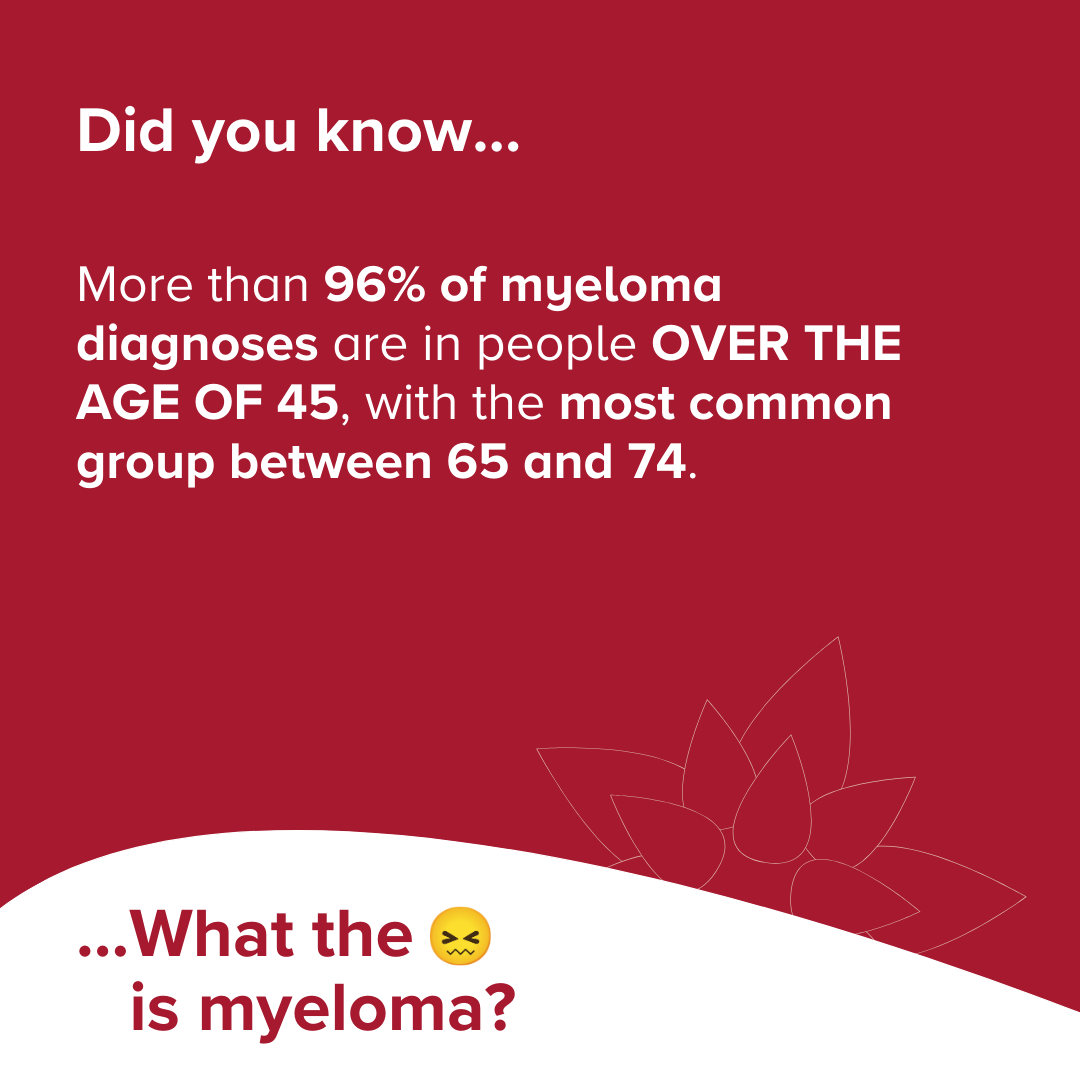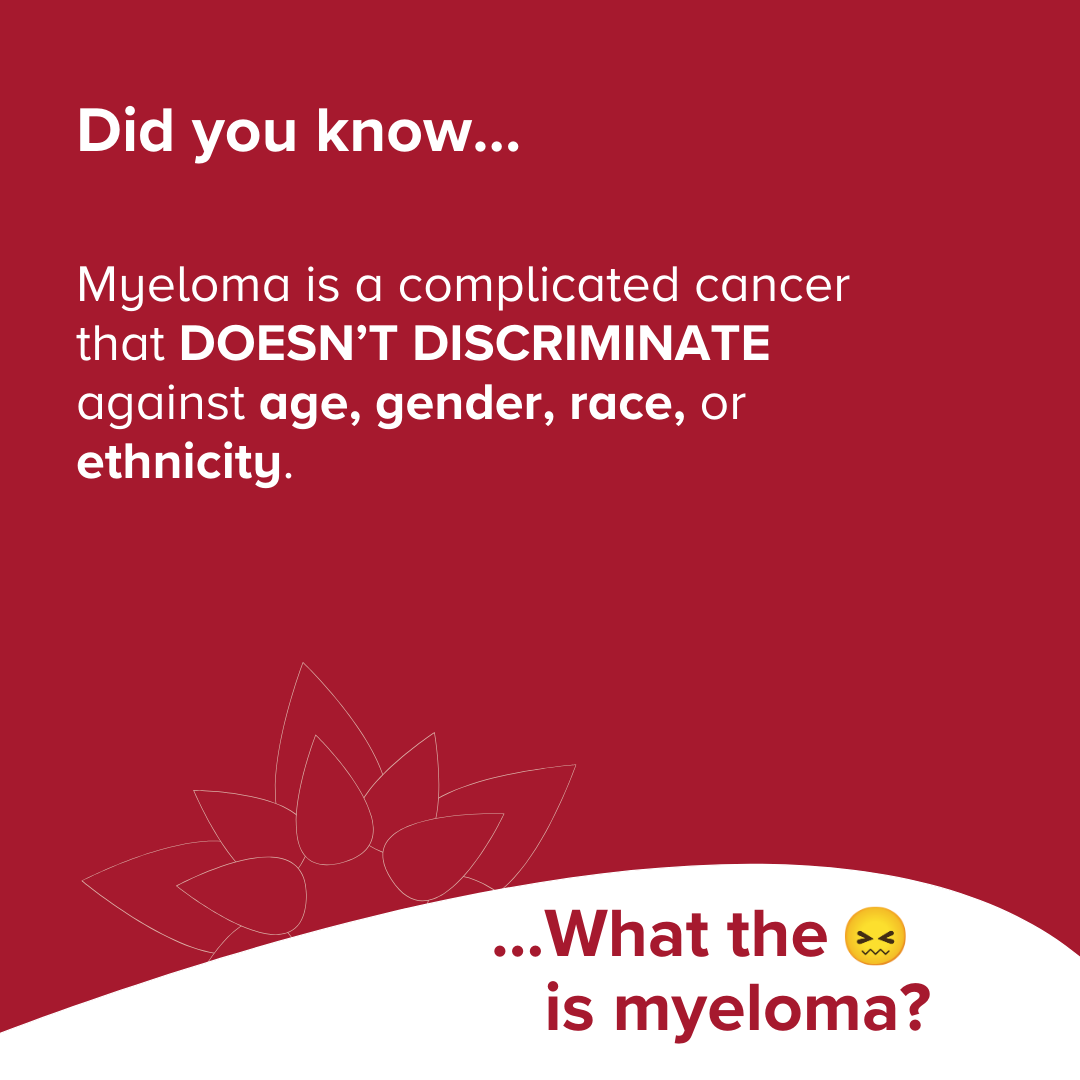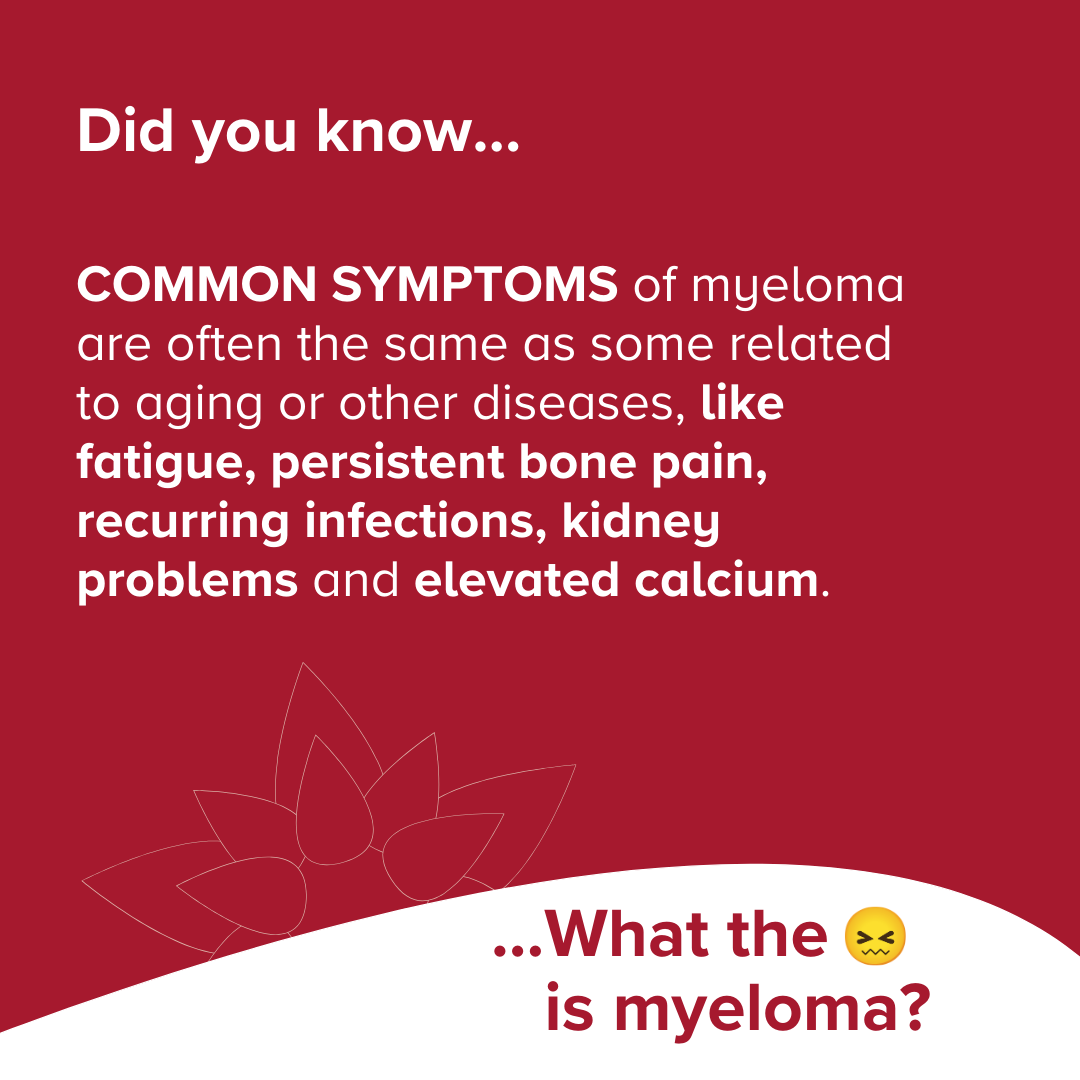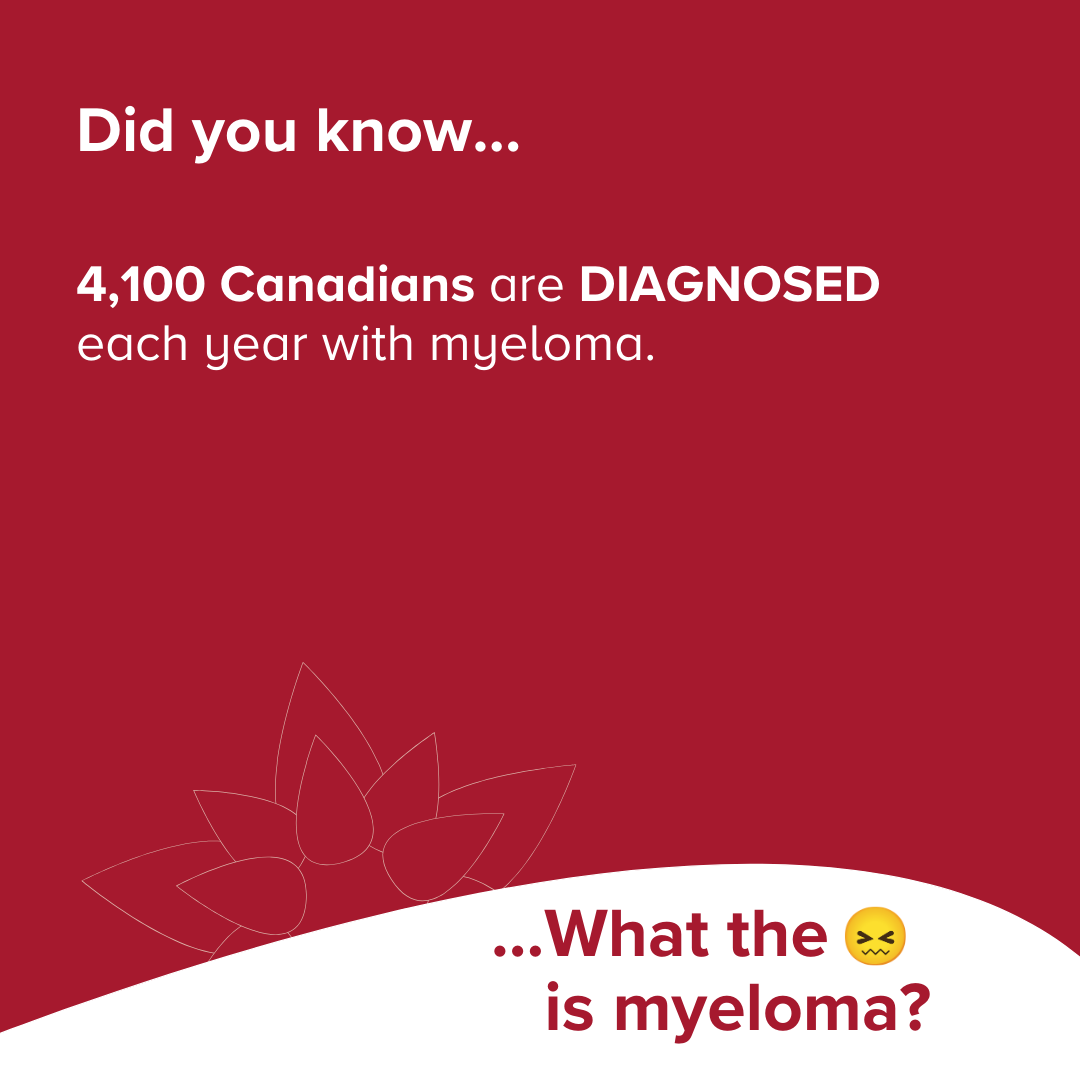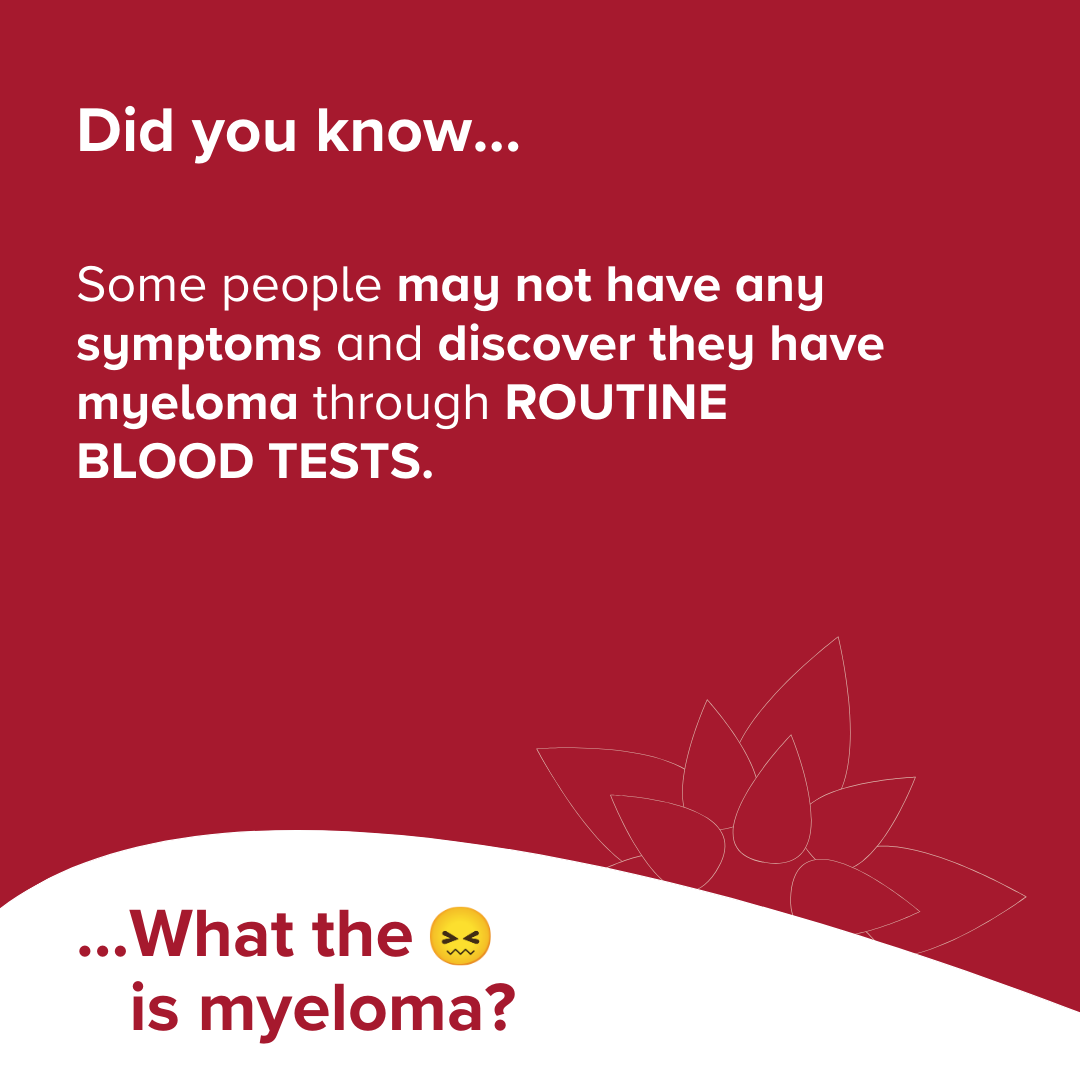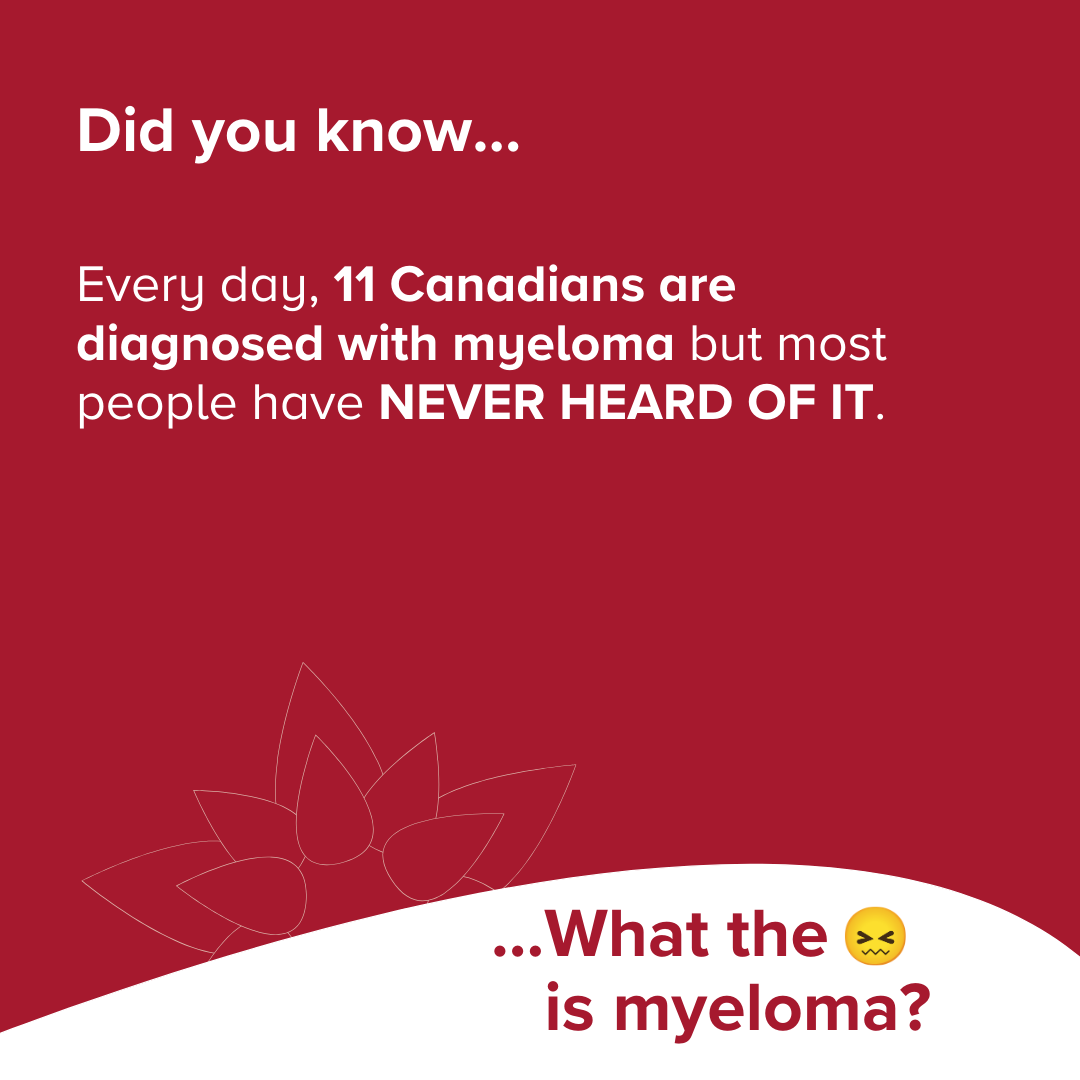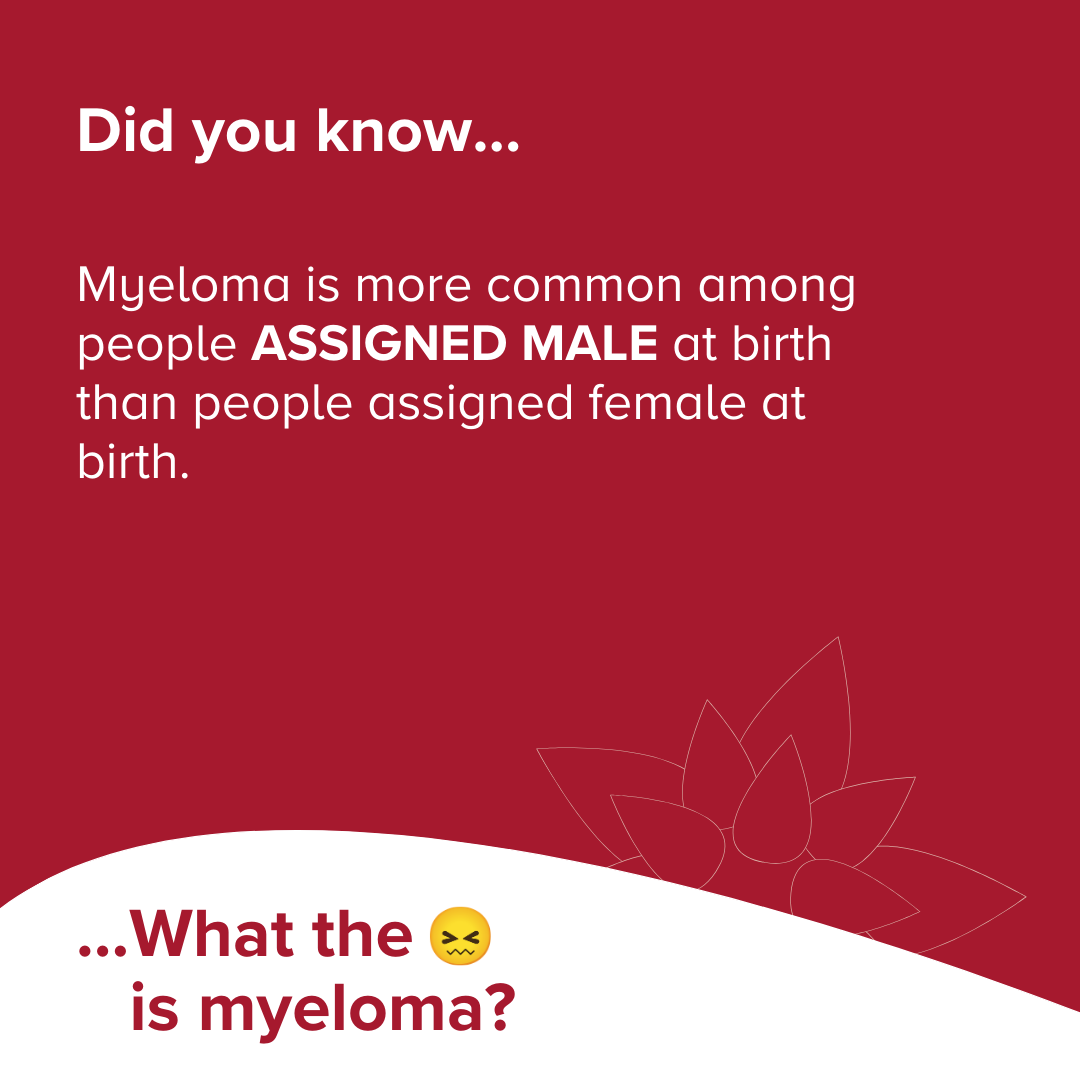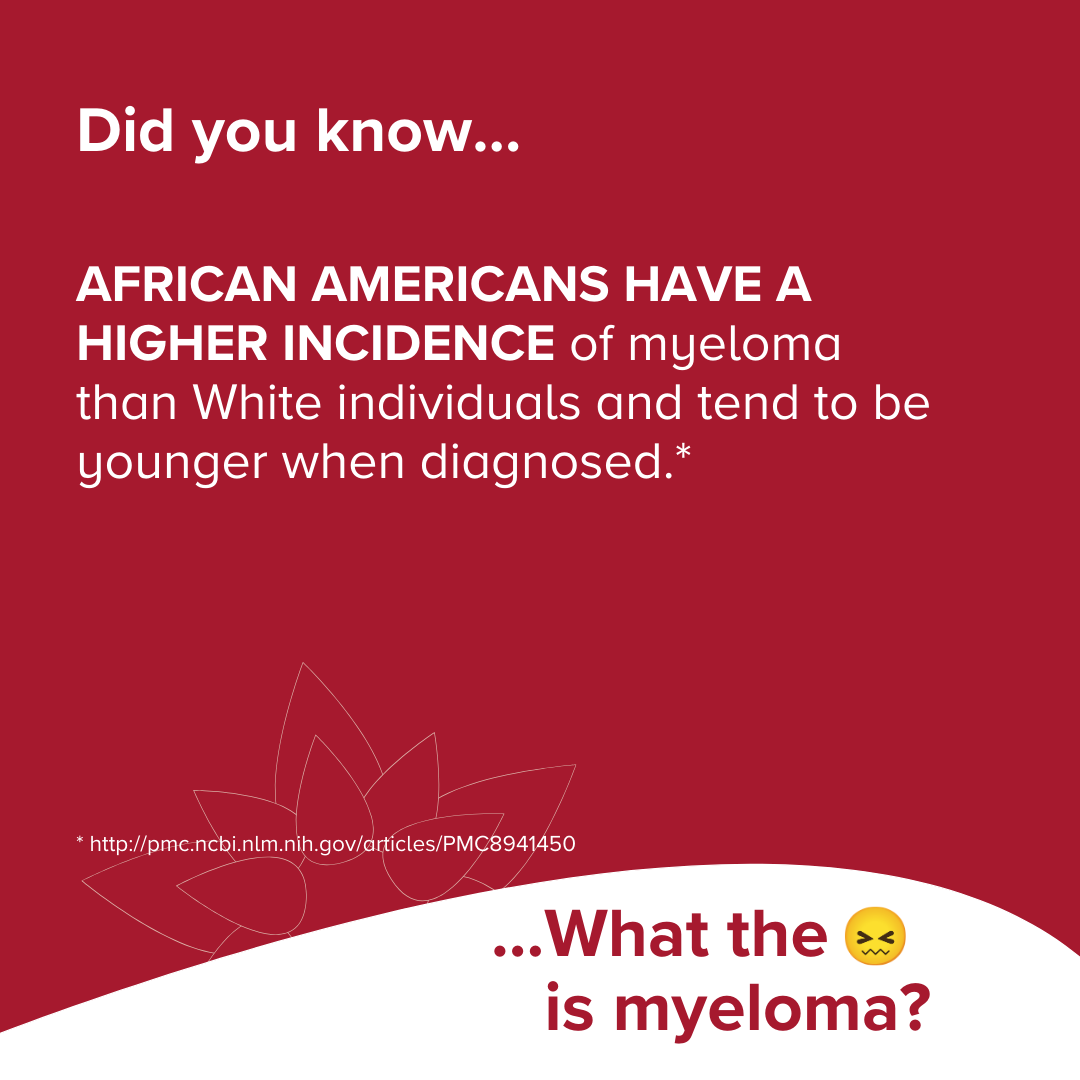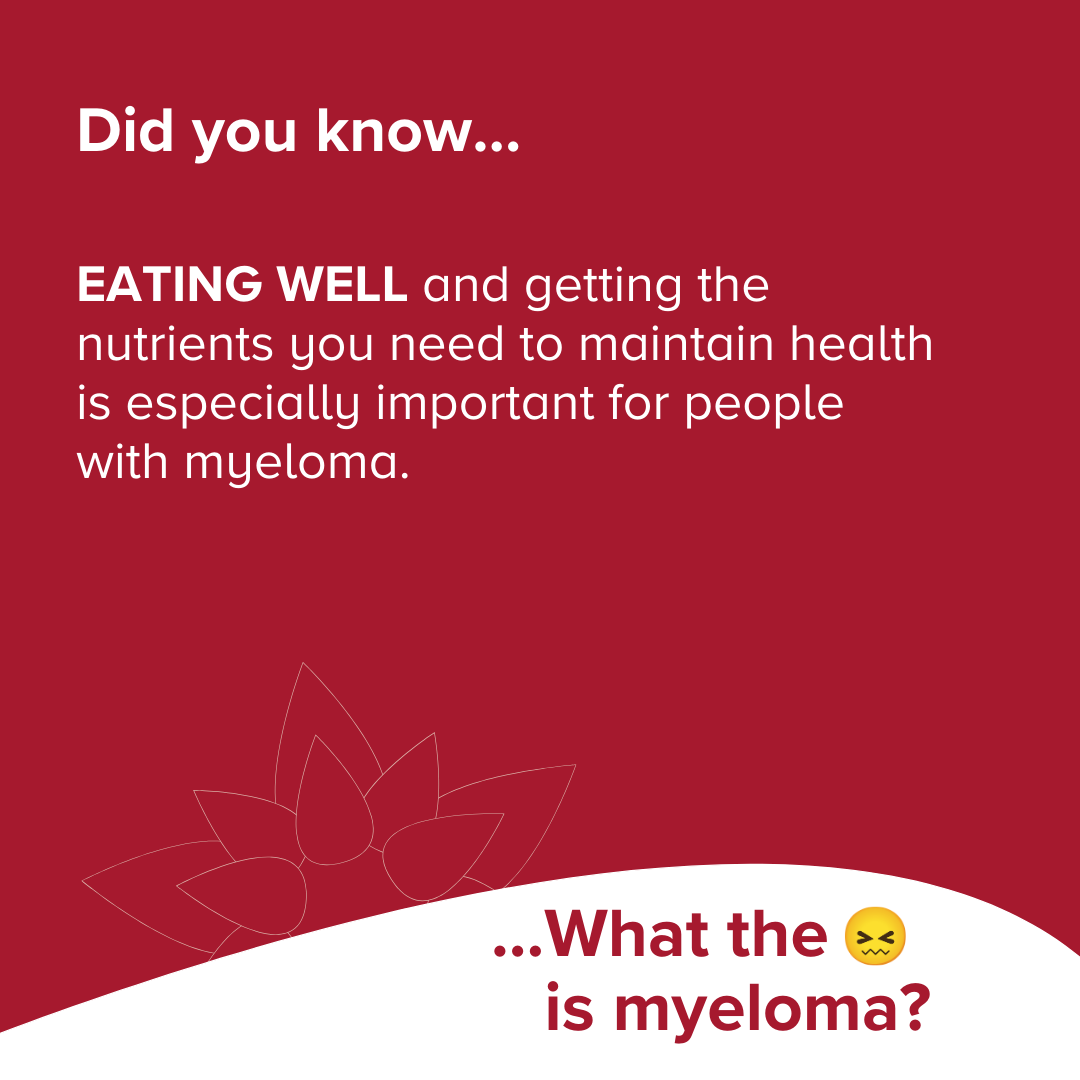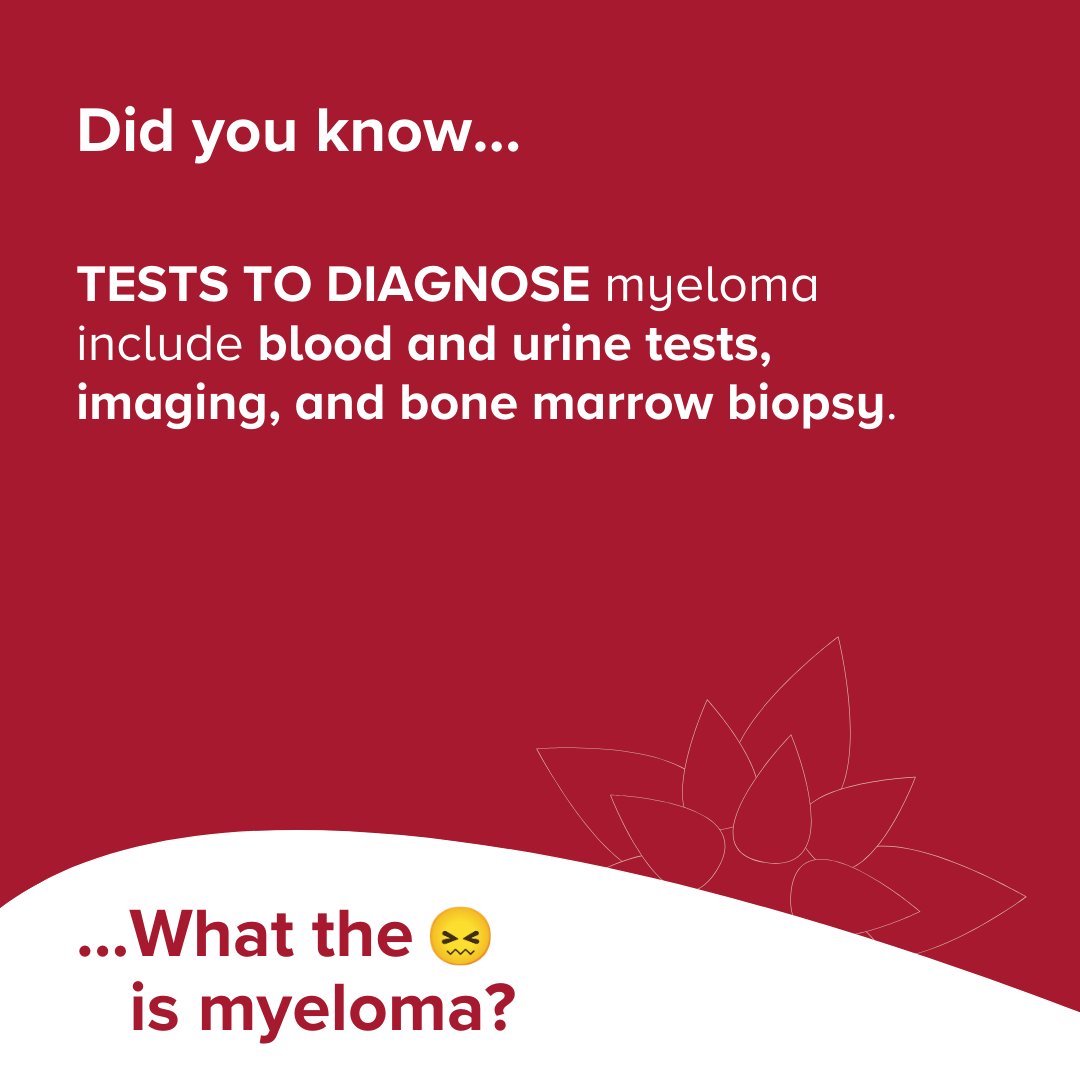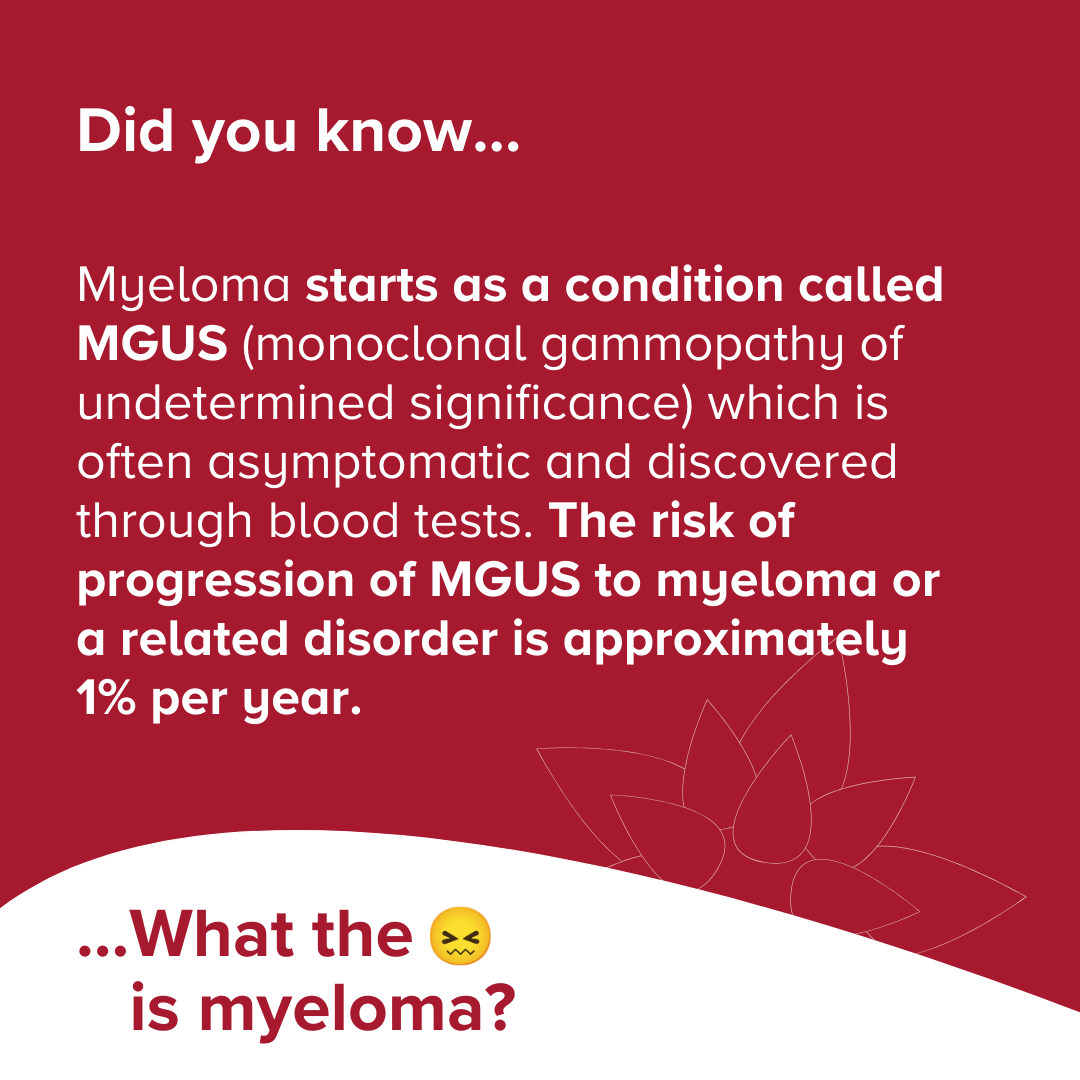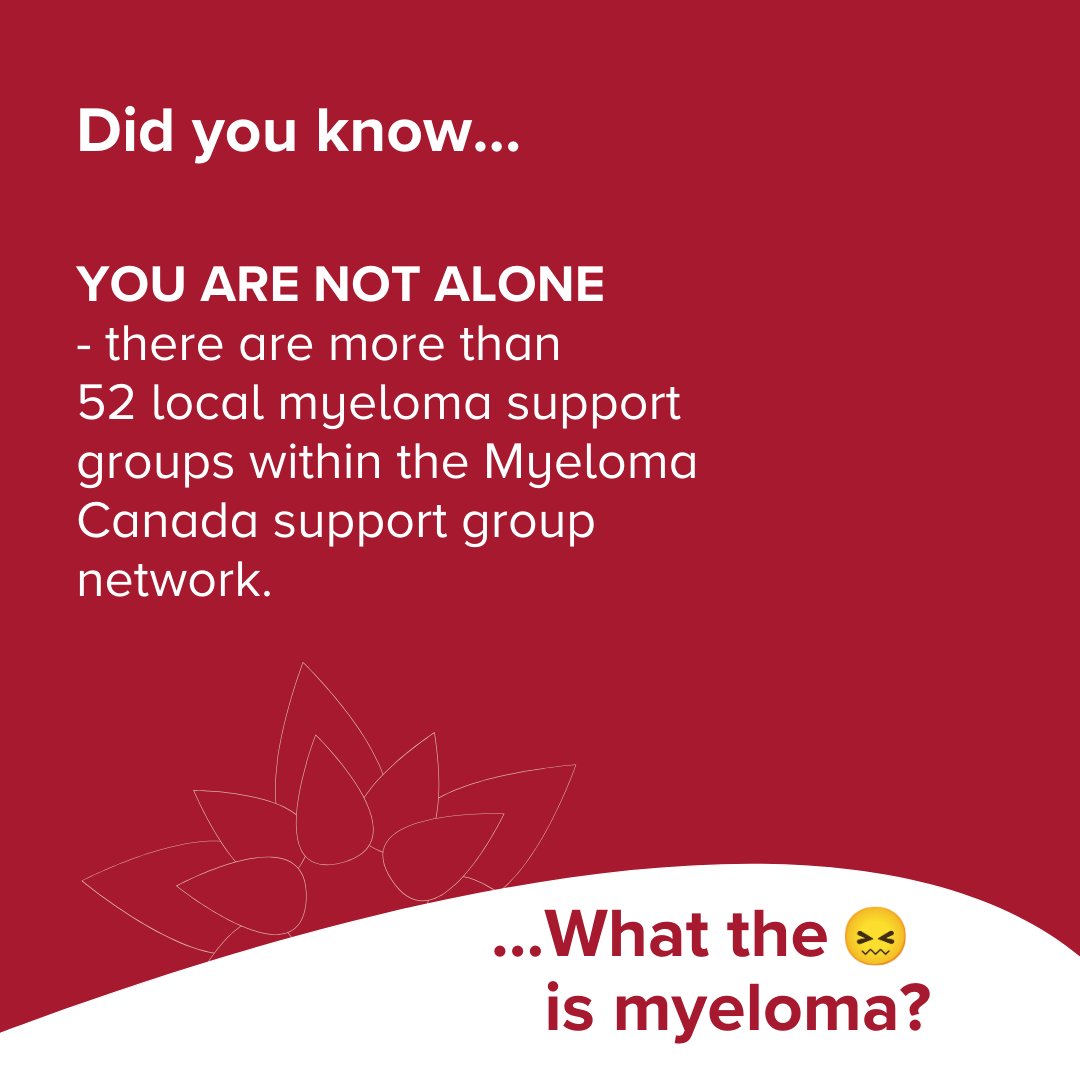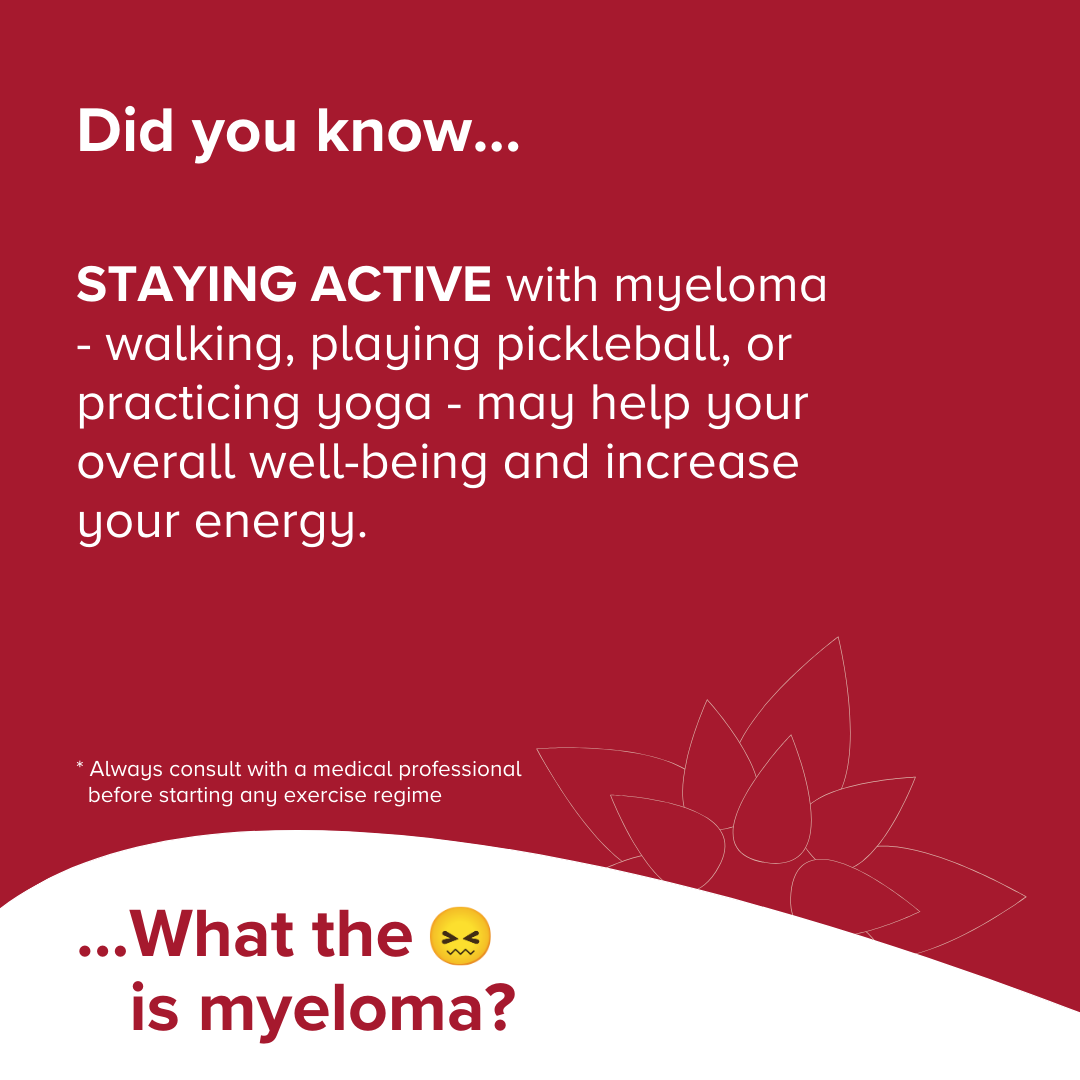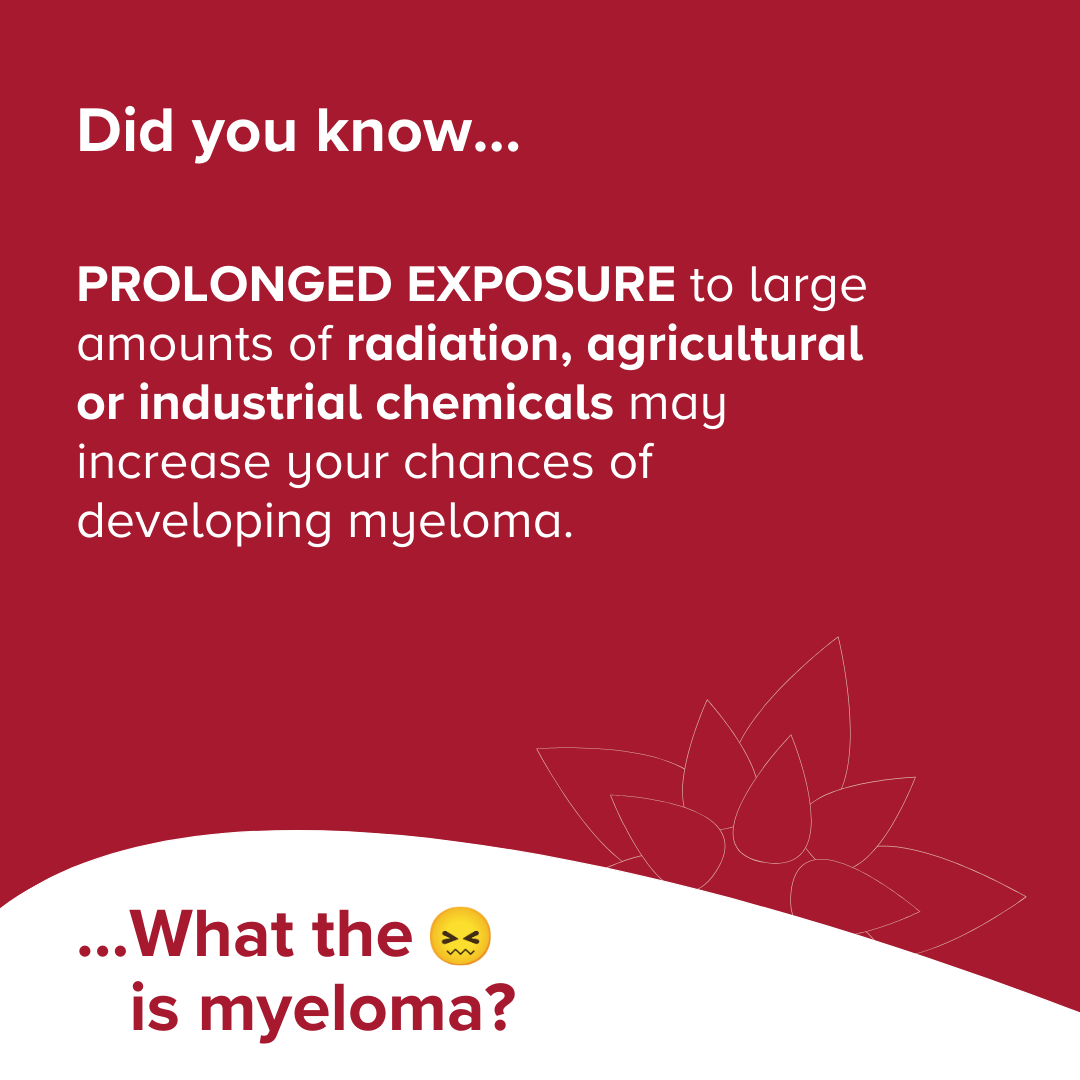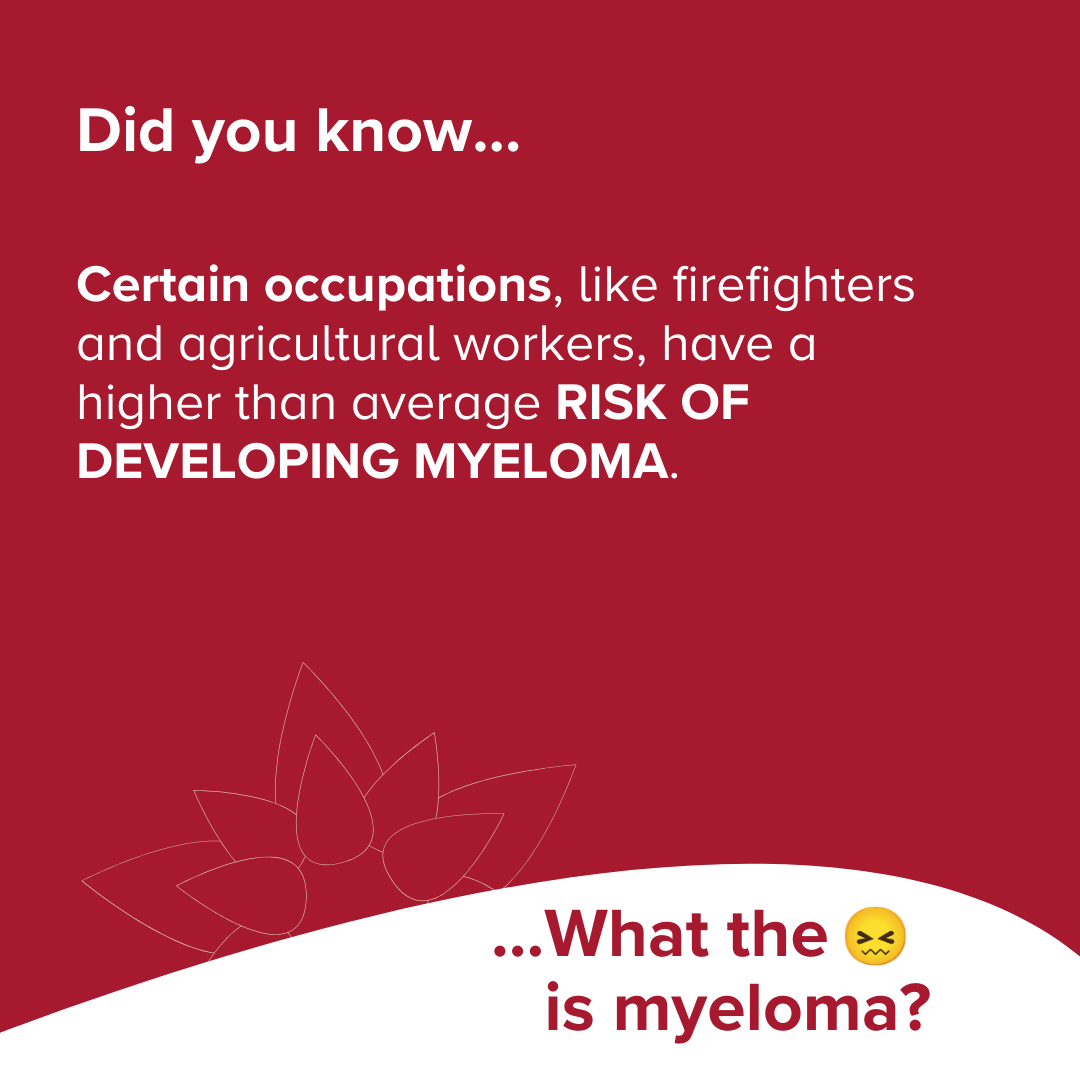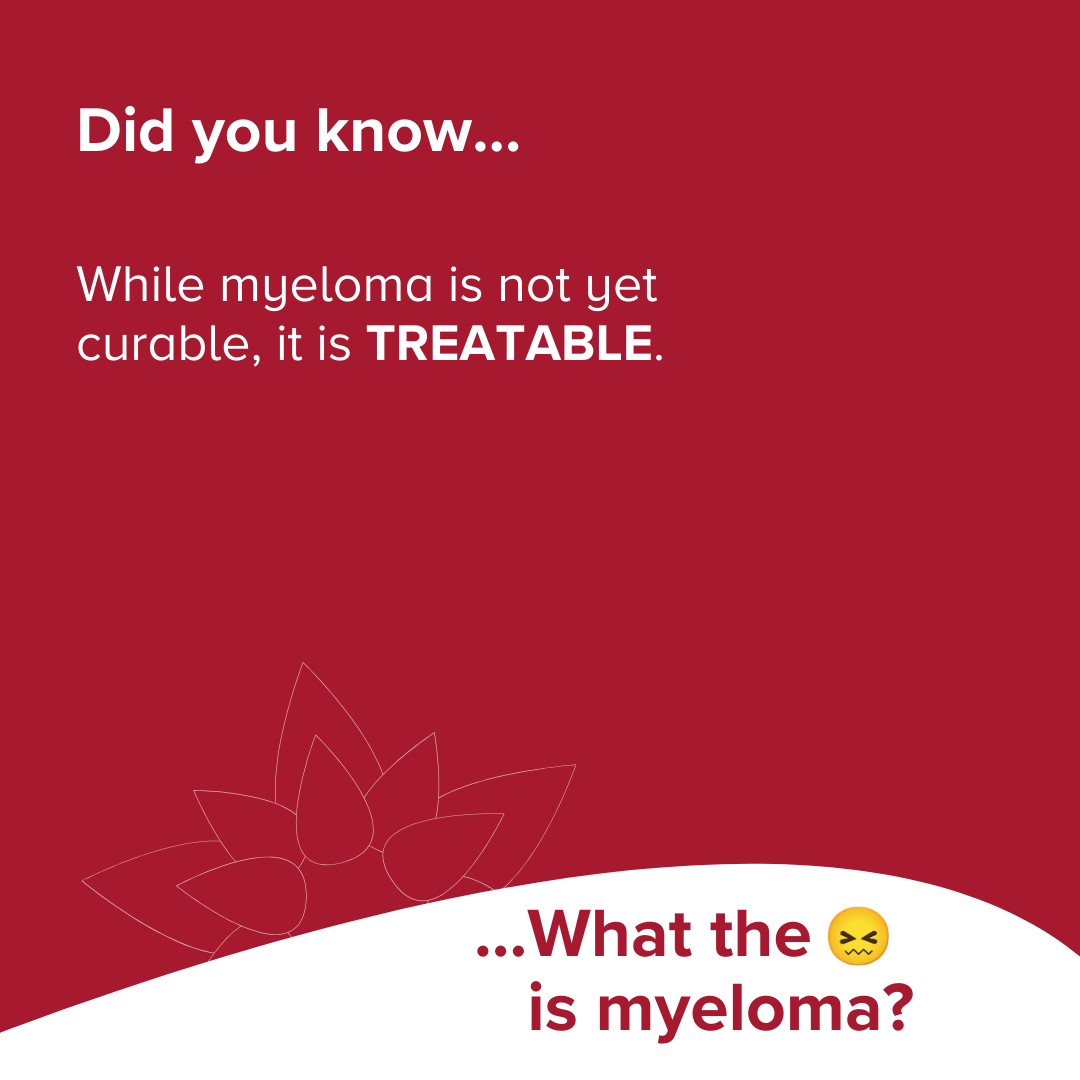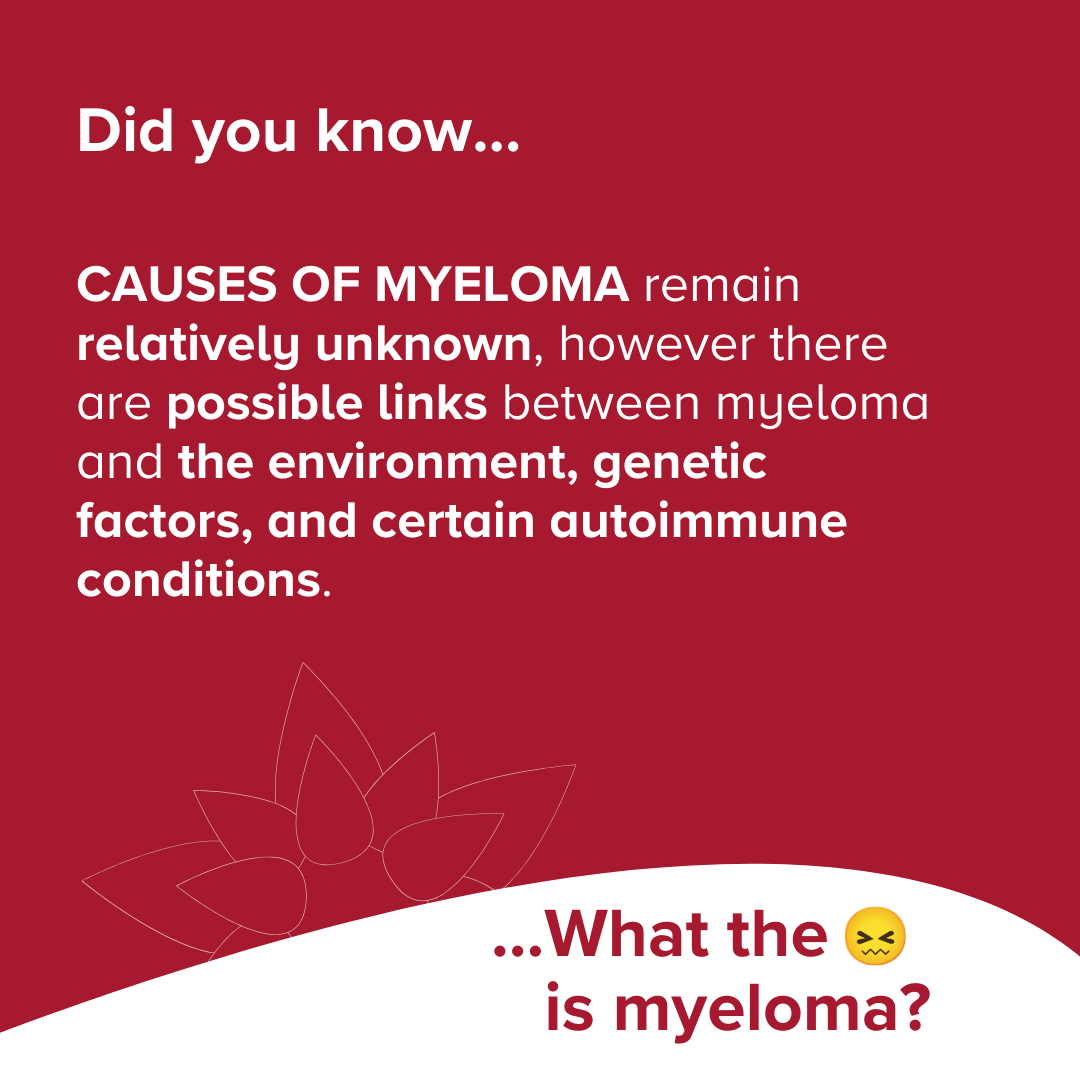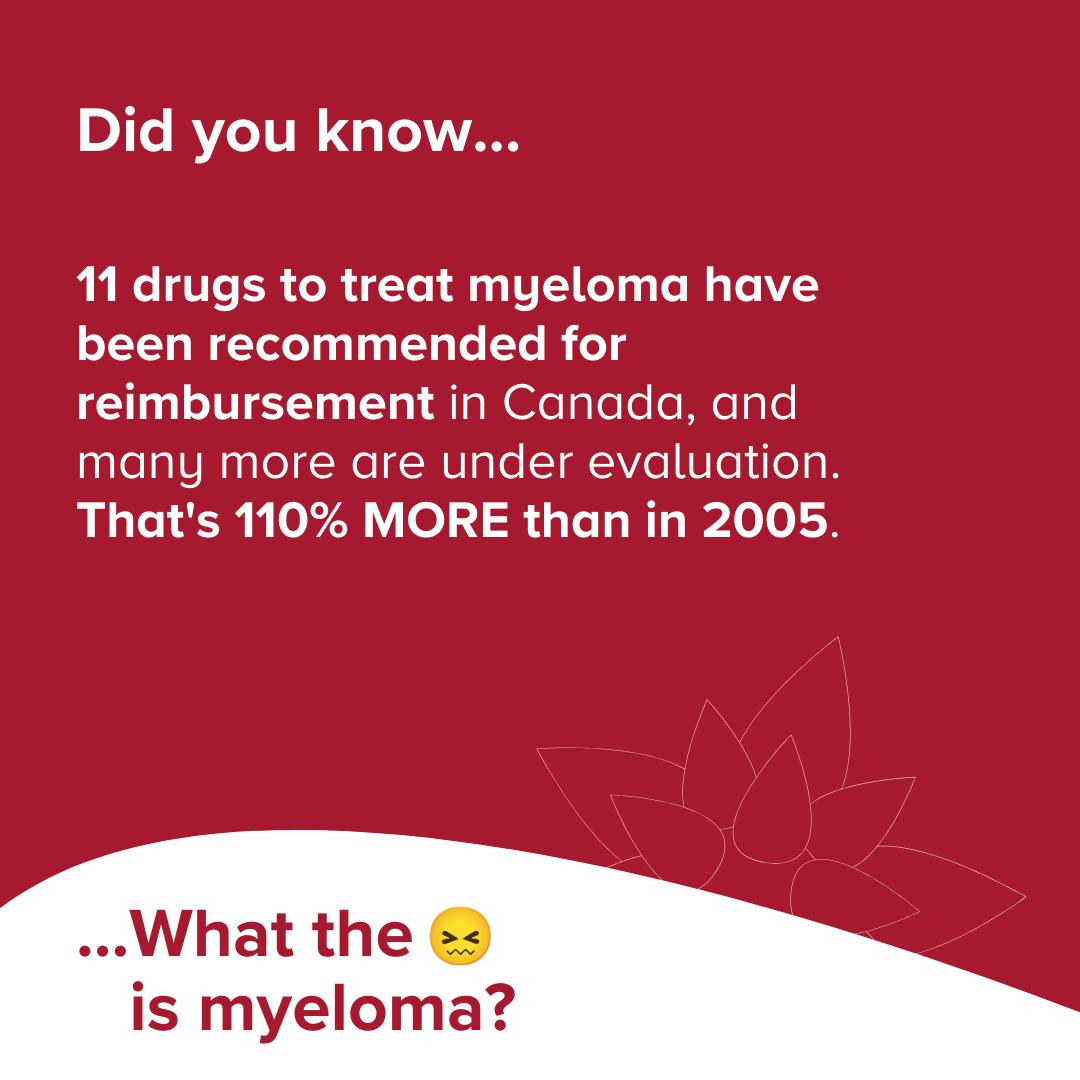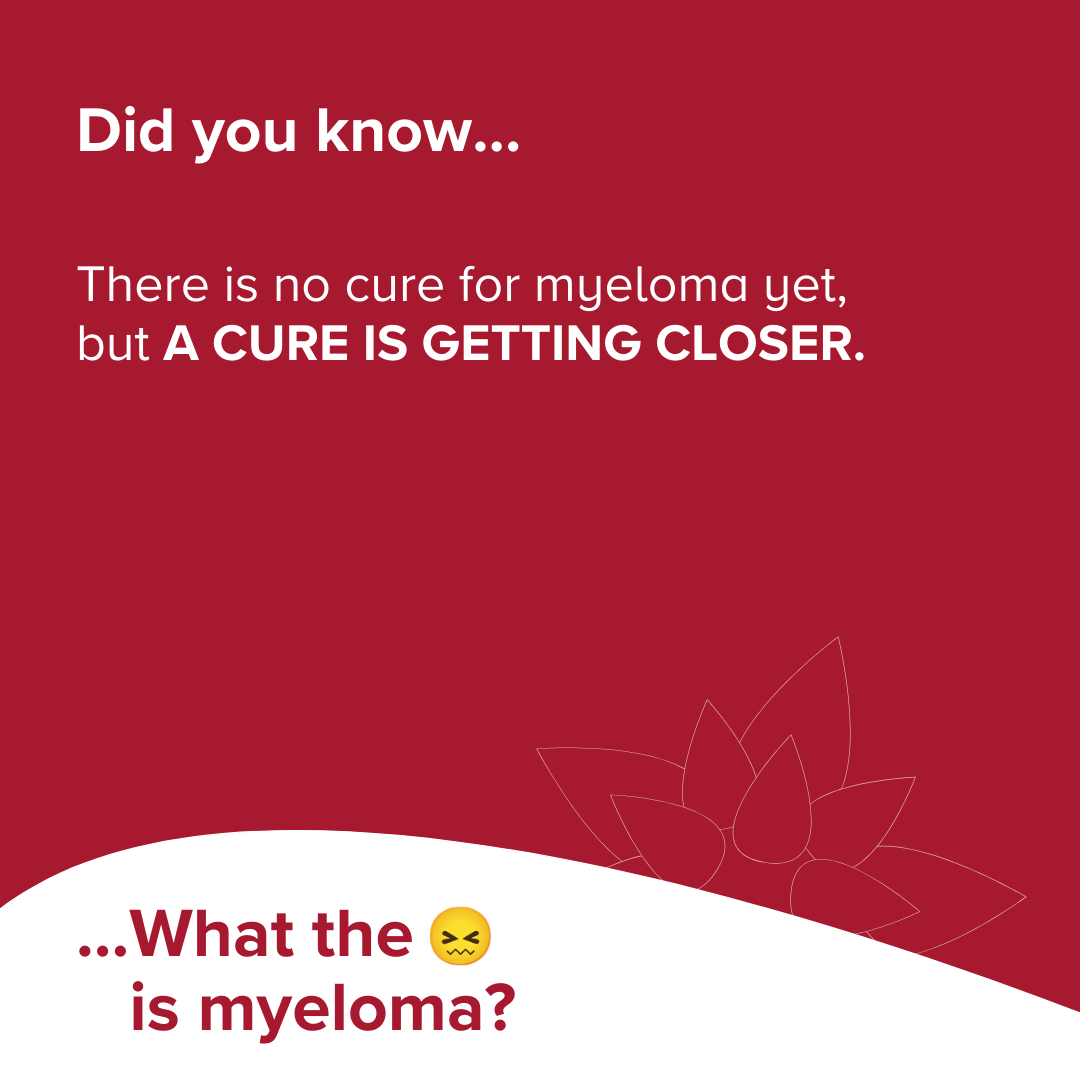March is Multiple Myeloma Awareness Month (MMAM)
Nearly 4,100 Canadians are diagnosed with multiple myeloma every year, but the vast majority of Canadians don’t know what multiple myeloma is.
And that’s a huge problem. Multiple myeloma, also known as myeloma, is the 2nd most common blood cancerA term for diseases in which malignant cells divide without control. Cancer cells can invade nearby tissues and spread through the bloodstream and lymphatic system to other parts of the body. that is still without a cure, for now. Creating awareness for myeloma is always important, but never more so than throughout the month of March, Myeloma Awareness Month.
Together, we can advance a future of hope for every Canadian affected by myeloma. Please give today.
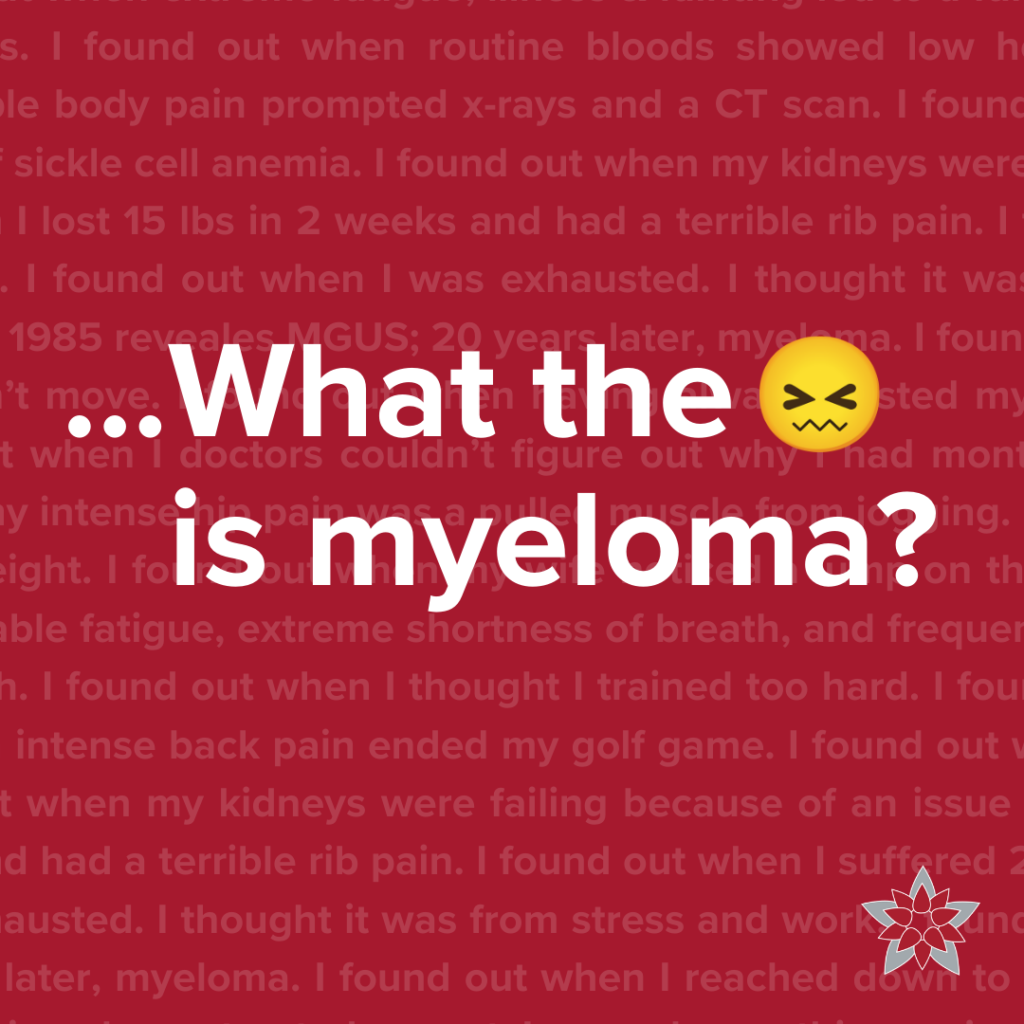
Why is increasing awareness for myeloma important?
- Improved awareness typically leads to earlier diagnoses, less disease progressionWhen a disease or physical ailment's course worsens, grows or spreads., and potentially better prognoses.
- Bringing myeloma out of the shadows and into mainstream conversations on cancer helps make it easier to find community, support, tools, and confidence to better manage life with the disease. Knowing you are not alone in a journey you’ve never asked to be on helps.
- The progress that continues to be made in discovering and implementing new treatment therapies fuels future research agendas and investments. We must do all we can to “stay ahead of the science” as our co-founder Aldo del Col used to say, so that lives are well-lived and saved.
- The more a disease is known, the more aggressively we can advocate for equitable drug access and funding amongst government bodies and payers.
Myeloma vs. melanoma
While myeloma may sound a lot like melanomaA cancer of the pigment-forming cells of the skin or the retina of the eye. Not associated with myeloma despite the similar-sounding name., they are most definitely not the same. Melanoma is a cancer that most often occurs in the skin; myeloma is a cancer of the plasma cellsSpecial white blood cells that produce antibodies. The malignant cell in myeloma. Normal plasma cells produce antibodies to fight infection. In myeloma, malignant plasma cells produce large amounts of abnormal antibodies that lack the capability to fight infection. The abnormal antibodies are the monoclonal protein, or M protein. Plasma cells also produce other chemicals that can cause organ and tissue damage (i.e. anemia, kidney damage and nerve damage)., a type of white blood cellThe basic unit of any living organism., or immune cell, in the bone marrowSpongy tissue that is found inside your bones. It is soft, fatty and full of blood vessels. Your bone marrow is where most of the blood cells in your body are made..
Signs and symptoms of myeloma
The signs and symptoms of myeloma can be as diverse as the people living with this complex cancer, which often makes it challenging to diagnose. That’s why it’s vital to create as much awareness for myeloma as we can.
We need to reach every Canadian in every town, city, province and territory to inform them of the often vague signs and symptoms of myeloma so that more people experiencing early signs don’t overlook them. The sooner myeloma is diagnosed, the sooner treatment may start, and the better the chances for a brighter prognosisThe projected outcome or course of a disease; the chance of recovery; the life expectancy..
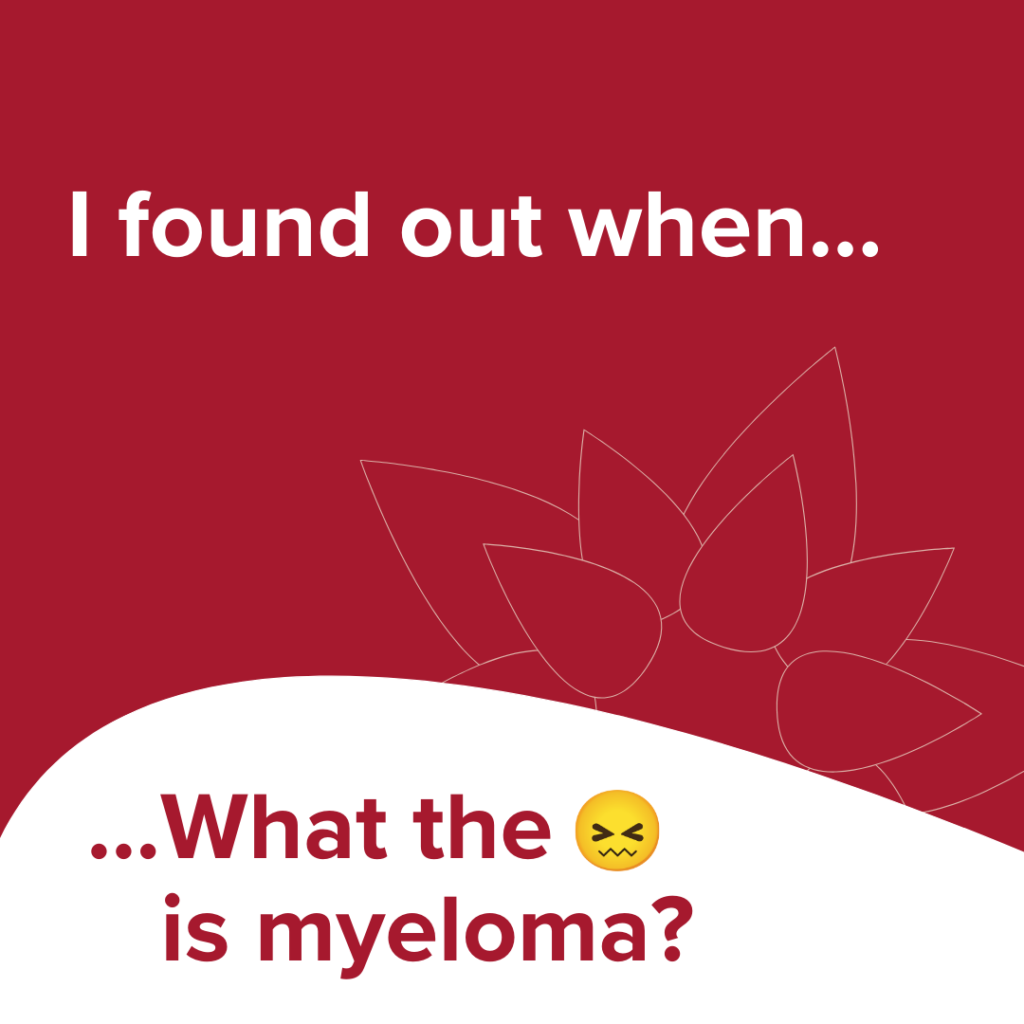
How you can help
Join us throughout the month as we introduce you to members of our Canadian community living with myeloma. Learn what prompted them to investigate their health, and ultimately how it led to their myeloma diagnosisThe process of identifying a disease by its signs and symptoms..
Create awareness for myeloma by liking, sharing/reposting our “I found out when…” and “Did you know…” posts, and add your own experience to them.
I found out when…
In honour of Myeloma Canada’s 20th anniversary, 20 members of our community with myeloma have generously offered to share their experiences across our digital platforms. Learn what prompted each one of them to investigate their health, and ultimately how that led to their myeloma diagnosis.
For them, and for the 11 Canadians who are diagnosed with myeloma each day, please give as generously as you can.
Alyssa, diagnosed in 2010 at 32 years old
I found out when…
I was officially diagnosed with multiple myeloma on February 4, 2010. I was 32 years old. My specialist confirmed I had active myeloma for at least 2 years prior because my m-protein was so high. I was told myeloma was rare for 30-year-olds, so it would not have been something that doctors were looking for. Given my symptoms were mostly related to blood and immune deficiency rather than typical bone symptoms, this also caused delays.
…My diagnosis took time, partially because of the barriers young adults face in getting diagnosed, but also because of the belief that multiple myeloma is a seniors’ disease.
Over time my list of symptoms also included neuropathy, extreme fatigue, constant headaches, stomach issues and a bleeding disorder. I had many doctor appointments, yet no one had answers for me…The only firm diagnosis I was ever given was that of a “stressed out young woman”.
Fainting episodes due to anemiaDecreased blood hemoglobin level. Hemoglobin is found in red blood cells and carries oxygen around the body. and electrolyte imbalances eventually led to my diagnosis by a compassionate ER doctor… I had never heard of multiple myeloma!
Kundan, diagnosed in 2016, at 54 years old
I found out when…
I was diagnosed with multiple myeloma at the very end of August of 2016. I was 54 years old but for sure I had been living with it for at least 2 years before.
In 2014, I suffered 2 vertebrae fractures. It happened at 2:30 in the morning in my sleep. I woke up in excruciating pain. My husband George immediately took me to the emergency department. They gave me morphine and then sent home.…They decided that I had early onset osteoporosisReduction in bone density typically associated with old age. Diffuse involvement of bones with myeloma produces what looks like osteoporosis on X-ray and bone density measurement..
…In the summer of 2016, I was at an Indian wedding where it’s the custom to sit cross-legged on the ground. I couldn’t do it for more than 20 minutes. I was in so much discomfort…
Later that day, I felt like I had 2 ‘Charlie horses’ in my buttocks just from sitting on the ground for 20 minutes! My husband took me to emergency and x-rays showed that I had two sacrum fractures and a pelvic fracture.
That Monday, I saw my family doctor who was concerned and ran blood work…my protein levels were through the roof! That’s when myeloma finally appeared on his radar.
We don’t have cancer in my family. I’m the first one, so I never suspected anything like this to happen…Up until my diagnosis in 2016, I had never heard of multiple myeloma.
Cyndi, diagnosed in 2015 at 39 years old
I found out when…
I was diagnosed with multiple myeloma in 2015 when I was 39 years old. I suffered excruciating back pain for months and the doctors could not figure out why. I thought I had pulled a muscle. I had been doing a lot of running training for a half marathon and was surprised that I couldn’t even run, the pain was too much. I was also having a hard time catching my breath.
After I consulted with physiotherapists, chiropractors, my GP and a massage therapist, we finally did an X-rayHigh-energy electromagnetic radiation used in low doses to diagnose diseases and in high doses to treat cancer. and found an inexplicable compression fracture. Then we found another one, and a third fracture, and at that point my kidneys started to fail.
An on-call doctor saw all of my symptoms and suggested multiple myeloma.
Kevin, diagnosed March 2023 at 53 years old
I found out when…
March 2023 changed my life forever. Came back from a vacation in the Dominican Republic and noticed a lump on the top of my head. My wife, the ever-curious nurse, poked and prodded it and thought I should see a doctor. I did.
After several tests and scans I got a phone call from my family doctor at 8pm one night. I knew it wasn’t going to be good news. No family doctor calls that late!…
I had never heard of multiple myeloma. No one in my family had anything like cancer.
Jean-François, diagnosed in 2017 at 44 years old
I found out when…
I have been a firefighter since 1996 and I am passionate about my work; after all, isn’t becoming a firefighter a dream for many kids?
Unfortunately, in the spring of 2017, multiple myeloma changed my life forever.
The first symptom appeared in April of that year. I had been feeling very tired for some time; I wasn’t aware that my body was being poisoned. At the time, my kidneys were failing, working at less than 10% of their normal capacity. Multiple myeloma had set in and it was invading my body.
Dwight, diagnosed Feb 2018 at 53 years old
I found out when…
“Dwight had unbelievable fatigue with extreme shortness of breath. Walking or getting in and out of a tractor, along with long hours, was very hard to accomplish. He already had a heavy history of heart problems and a previous surgery for an aortic aneurysm and ventricular septal defect.
Dwight was diagnosed with multiple myeloma (MM) in February 2018…Then, four months later, Dwight was also diagnosed with AL amyloidosisA condition in which myeloma light chains (Bence Jones proteins) are deposited in tissues and organs throughout the body. This occurs more commonly with lambda versus kappa Bence Jones proteins. In patients with amyloidosis, the light chain proteins bind to certain tissues such as heart, nerves and kidney rather than being excreted out of the body through the kidneys. in his kidneys and heart. And so our nightmare began.”
Megan, Dwight’s wife
Ron, diagnosed in 2012 at 67 years old
I found out when…
In October 2010, I cracked my ankle playing golf. Expecting a rapid recovery, I was disappointed that it showed no signs of healing two months later. My GP suspected something so had me take a Bence Jones urine test. In the meantime, I had two painful and unusual falls while skiing.
Francis, diagnosed in 2020 at 63 years old
I found out when…
The reduction in my platelets didn’t seem abnormal as my family has a history of sickle cell anemia; my mother was a carrier. I went to the oncologistA doctor who specializes in treating cancer. Some oncologists specialize in a particular type of cancer treatment. thinking that all would be well, and this would be sickle cell related.
The bone marrow expiration was difficult, I had to do it twice, but still, I remained optimistic.
When I was asked to come into the doctor’s office on August 27, 2020, I knew that the news was not what I expected.
Ellis, diagnosed in 2005 at 60 years old
I found out when…
Myeloma has certainly been a challenge in my life. But I’ve tried to not miss a beat. I’ve embraced my condition and surrounded myself with the best medical team to help me through the process.
I’ve been on many treatments over the years that have collectively been able to keep my disease in remission!
My myeloma has also helped me become more spiritual. I have created lists of my beliefs and gratitudes and attributes and goals which I review daily.
Jules, diagnosed in 2013 at 47 years old
I found out when…
June 11, 2019: I was diagnosed with multiple myeloma about five years ago. The doctor told me I had high blood pressure which had never had before. She put me on a blood pressure pill and the next morning I started to have all these symptoms while I was at church. When I got to the hospital, they did a test and told me that my kidneys were failing. They did not know why this was all happening; they thought it was just the pill.
I had a biopsyThe removal of a sample of tissue for microscopic examination to aid in diagnosis. and they found that there was something wrong with my blood. That’s when they found out that it was multiple myeloma that that’s why my kidneys were failing. It was totally out of the blue I had no idea what this was. When my doctor came in to tell me about it, it was a shock. As soon as she said “cancer”, I just froze. I didn’t hear anything she said after that. I just started to cry.
Pierre, diagnosed in 2020 at 60 years old
I found out when…
For several months before the diagnosis, I felt extreme fatigue and experienced unexplained weight loss. Being a very active person, I noticed these changes quickly. Every time I went for a run, a bike ride, or a swim with my friends, I found it increasingly difficult to keep up. I thought I might be overtraining which would have explained my constant fatigue and sudden weight loss.
Despite my healthy lifestyle, on December 22, 2020, I was diagnosed with multiple myeloma: an incurable form of blood cancer.
Paule, diagnosed in 2021 at 53 years old
I found out when…
In April of 2021, at the age of 53, I was diagnosed with multiple myeloma. Fifty three years of a life with its share of ups and downs!
A few years ago, I was diagnosed with cutaneous lupus as well as sickle cell trait disorder which leads to extremely low hemoglobin levels. At the time, I noticed my body needed rest after exerting a lot of energy or after a long trip. However, since 2019, the fatigue seemed more constant. I suffered from pain all through my body: my neck, back, hips, stomach, and head; I was also starting to worry about my concentration. In short, it was not going well.
Ev, diagnosed in 2000 at 46 years old
I found out when…
My journey with multiple myeloma began 25 years ago in 2000.
I had blood work done when I had my physical two or three months earlier and results came back showing a low hemoglobin with a comment by the lab, “sticky cells.”
The comment “sticky cells” raised a red flag and my family doctor ordered more tests and told me something was wrong with the protein in my blood. I had no idea what that meant but I didn’t think it was cancer. I was referred to a hematologistA doctor who specializes in the problems of blood and bone marrow. where I was given the devastating news.
Jean Guy, diagnosed in 2020 at 62 years old
I found out when…
“Living in a small community makes you feel isolated, as if you don’t have choices, a right to a second opinion or the best care possible.
When my husband was diagnosed, one blunder after another nearly cost him his life. Difficulties with appointments for essential procedures and approvals for the drug we wanted led us to travel hundreds of kilometres and change treatment centres. The trips are difficult and expensive but what choice do we have?”
Erin Belzile, Jean Guy’s wife
Betty, diagnosed in 2018 at 62 years old
I found out when…
I figured my tiredness and low energy were due to the fact that work was crazy busy. I had a new supervisor and more responsibilities. I started eating my lunch in my car so I could take a quick nap every day.
On Canada Day, I went to make myself something to eat, and I struggled to open the fridge door … a stainless steel fridge door!
” Okay, so maybe I should go to the doctor! ”
Bob, diagnosed in 2006 at 55 years old
I found out when…
In 2006, I started having a lot of pain in my right hip. I just assumed that I had pulled a muscle as I was a jogger in those days. About a month later, the pain had not improved so I went to my family doctor. He too felt that it was probably muscular however to be on the safe side, he suggested we x-ray the hip.
I had a follow-up appointment with him one week later. When I went into his office, I was expecting to hear a muscular diagnosis and nothing else. You can appreciate the shock of being told that there was a strong suspicion of cancer, and in particular, of multiple myeloma!
Tanya, diagnosed in 2019 at 37 years old
I found out when…
In March of 2019 we went on our first cruise as a family. We were super excited. My kids are major Disney fanatics as am I. By the time I came back from the cruise, I was down 15 lbs over a course of about two weeks.
I had major rib pain, which is a very common symptom of myeloma, which at the time I did not know. The Friday before Mother’s Day weekend, I received a call. “You better sit down…You have multiple myeloma.”
Anthony, diagnosed in 2015 at 47 years old
I found out when…
I had been experiencing severe pain in my back and ribs for about a year but as I was working out a lot, my doctor put me on muscle relaxants and arthritisA disease that causes inflammation and pain in the joints. medication.
However, that Monday evening as I reached down to unlock my bike, I couldn’t move. There was a strange loss of feeling in my back and legs.
Yolande, diagnosed in 2012 at 58 years old
I found out when…
A year after I retired, I met with my family doctor for my annual physical. My white blood cellsMinute structures produced in the bone marrow; they include red blood cells, white blood cells, and platelets. and neutrophils were just below normal. Despite his assurances, my instincts told me that something was wrong.
I trust my intuition and I had experienced more frequent colds and infections that year; unusual for me.
Bayo, diagnosed in 2016 at 52 years old
I found out when…
I had been having pain in my body for a while, especially in my left arm. I thought it was from sitting for long periods of time in front of the computer. But in early 2016, the pain became so intense that I went to our family doctor for a checkup. He ordered some blood work, gave me anti-inflammatory medication, and said the pain was from the inflammation.
When the results of my blood work came back, he said there was a concern – my results showed a high percentage of protein in my blood.
Thank you!
A huge thank you to Ellis Basevitz, Jean Guy Belzile, Betty Boudreau, Jean-François Couture, Francis DelSol, Paule Désir, Alyssa Dickey, Ron Drennan, Dwight Gardiner, Kevin Jacobs, Pierre Laforest, Cyndi Logan, Bob McCaw, Ev McDowell, Anthony Mohamed, Bayo Oladele, Yolande Paine, Jules Royer, Kundan Uppal-Dubinsky and Tanya Zigomanis for lending their faces, voices, and experiences to this year’s campaign.

Raising awareness together
Together let’s do what we can to increase awareness for myeloma clear across the country. The more people who learn about myeloma, the more empowered they’ll be to recognize possible signs and symptoms in themselves or someone they love, and not wait to seek proper medical attention.
Every shared post matters in making myeloma matter. We need you to help us reach beyond our community so that no one receiving a diagnosis will say,
What the 😖 is myeloma?

Share your story!
- Download the “I found out when…” art.
- Post it on your social media along with your personal story. What was YOUR defining moment when you knew something was wrong?
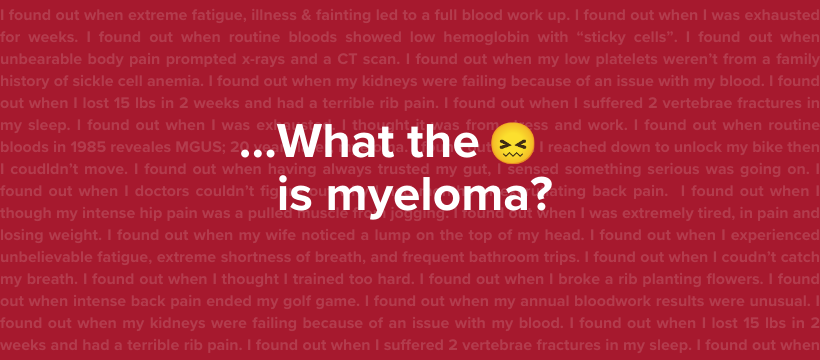
Change your Facebook cover photo
Change up your background cover photo to our campaign messaging and help spread the word.
Other ideas
- Contact your local media (newspaper, radio or TV station) and offer to share your story with them.
- Give an in-person or online/zoom talk at your community centre, public library, place of worship, yoga, running, or knitting group, book club, or any group you belong to!
- Explain what myeloma is to those who may not be aware.
- Discuss the effects of myeloma on your life with your online community, friends and loved ones who don’t know much about the subject.
- Hold a fundraiser in your community. It’ll give you the opportunity to create awareness and raise funds at the same time! (Reach out to Patricia Celestin at [email protected] for ideas!)
- Learn about new available treatments or clinical trials and discuss your options with your support system and healthcare team.
- Review your treatment goals and share them with your online community, as well as your family and friends.
- Get involved in a local or virtual support group or help create one in your area if there isn’t one already.
- Read and share articles with your friends and family and ask them to do the same.
- Direct your online and personal community to myeloma.ca to learn more.
Did you know…
“Thanks to the generous support of Myeloma Canada’s donors, we are able to advance important research projects that help improve our understanding and treatment of multiple myeloma, leading us closer to a cure. From novel therapies, to studying the impact of myeloma on diverse populations, to developing personalized treatment approaches, we’re driving progress for more effective treatments and better patient outcomes. But all of this requires funding.”
Dr Julie Stakiw, MD
Oncology & ClinicalInvolving direct observation of a patient. Professor Hematological Oncology
University of Saskatchewan
Please donate today.
Did you know…
Myeloma is a complex cancer that can affect each person differently. Some may experience bone pain while others none at all. That’s why there’s no such thing as “one treatment fits all” when it comes to treating myeloma. What works for one person may not work for another; each case must be assessed individually for the best outcomes.
Did you know…
Myeloma can be difficult to diagnose. Its signs and symptoms are often vague and wrongly attributed to stress, aging, or another physiological disorder. Know what to look for and trust your body. It could make a huge difference.
Did you know…
The majority of myeloma diagnoses are in folks over the age of 45, and so symptoms are often dismissed as common signs of aging. That’s why it’s critical to know the symptoms and ask your doctor direct questions if you feel something is off, no matter how old you are.
Did you know…
Myeloma is a complex blood cancer that can affect anyone, regardless of age, gender, race, or ethnicity. It is not, ‘just an older person’s cancer’. While it may be more common in older populations, people in their 20’s through to their 90’s are also hearing the words, ‘you have myeloma’. The same holds true for race and gender. While myeloma is more prevalent in the Black male population, myeloma doesn’t belong to one race, gender or ethnic group.
Did you know…
When thinking about myeloma, think CRAB:
- Calcium – elevated levels
- Renal (kidney) problems
- Anemia/fatigue
- Bone pain or unexplained fractures
Did you know…
4,100 Canadians are diagnosed with myeloma every year. Thanks to better diagnostics, advances in treatments and drug therapies, coupled with an aging population, there are more individuals living with this disease than ever before, yet awareness for the disease is still lagging.
Did you know…
In the early stages of myeloma, some folks don’t experience any symptoms at all. That’s why it’s important to keep to your regular check-up schedule and follow through when your doctor suggests a test. Myeloma is sometimes discovered through routine blood tests.
Did you know…
Every day, 11 Canadians receive a diagnosis of multiple myeloma. Most people hear of myeloma for the first time at the time of diagnosis. Raising awareness of myeloma, its signs and symptoms, is vital for earlier diagnosis, fewer disease-related complications, and the chance for better prognosis and quality of life.
Did you know…
While myeloma is more common among people assigned male at birth, the disease does not discriminate. Everyone should know its signs and symptoms.
Did you know…
Research has shown that the African American community has a higher incidenceThe number of new cases of a disease diagnosed each year. rate of myeloma than other populations.* Take the stigma out of cancer and talk about your health. If you are living with myeloma, share your experience – it’s a powerful way to put a human face to the disease, let others know they are not alone, and increase representation within the myeloma community.
Did you know…
It’s important for anyone to maintain a balanced diet, but eating healthy is especially important for people living with myeloma. Check out Myeloma Canada’s easy to make, delicious and nutritious recipes that were created specifically for people living with the disease.
Did you know…
Myeloma can be difficult to diagnose because it is a lesser-known cancer with symptoms that can be similar to those of other diseases. To get a diagnosis, you may need to go through multiple tests—blood and urine tests, imaging, bone marrow biopsyRemoval of bone marrow tissue for examination under a microscope., and more.
Did you know…
MGUS (monoclonal gammopathy of undetermined significance)A benign condition in which the M protein is present but there is no underlying disease., a condition detected through blood tests, may lead to smouldering multiple myeloma (SMM) and/or myeloma. Most people with MGUS don’t experience any symptoms, and treatment is not required. It’s important to note that only a very small percentage of people with MGUS or a related disorder – approximately 1% per year – will progress to myeloma.
If you’ve been diagnosed with MGUS or SMM, be sure to keep all your healthcare appointments so if there are any changes to your health, you can act on them as quickly as possible.
Did you know…
Being diagnosed with myeloma is scary, not only for the person receiving the diagnosis but also for the people they love. But remember, you are not alone! Myeloma Canada has a network of over 50 support groups located across Canada where you and your loved one can connect with others going through some of the same things you are.
Did you know…
Staying active is so important for your mental health, your energy, and your overall well-being. All you need is to find something you enjoy doing. Just starting out? Check with your doctor to see what’s right for you, including Myeloma Canada’s exercise program, designed specifically for people living with the disease.
Did you know…
Prolonged exposure to large amounts of toxic chemicals may increase your risk of developing myeloma. If your job requires you to come into regular contact with large amounts of radiation, agricultural, and/or industrial chemicals, it’s important to understand the possible links between cancer and the chemicals you encounter throughout your day.
Did you know…
Are you aware of the higher-than-average risk occupations for developing myeloma? These include firefighters, agriculture workers, petroleum workers, machinery production workers, carpentry and leather industry workers, and others who are regularly exposed to pesticides, benzene, organic solvents like methyl chloride, asbestos, and ionizing radiation.
Creating awareness and advocating for change is essential.
Did you know…
Myeloma may not yet have a cure, but it IS treatable and becoming more manageable thanks to incredible progress in innovative drug therapies, diagnostics, and increased awareness.
Advances in immunotherapyTreatment that stimulates the body's natural defenses to fight cancer. Also called biological therapy., precision medicine, and innovative drug therapies are offering people with myeloma more targeted, effective treatment options.
Did you know…
Like many cancers, the causes of multiple myeloma are still relatively unknown. However, research has revealed possible links between myeloma and certain environmental and geneticInherited; having to do with information that is passed from parents to children through DNA in the genes. factors.
Did you know…
Hope exists in a myriad of places. For many folks diagnosed with myeloma, hope is found in the treatment options they have access to. In Canada, there are currently 11 myeloma drugs recommended for funding. That’s 110% more than there were in 2005. Advocating for access to these drugs is a critical part of the work Myeloma Canada does.
Did you know…
There is still no cure for multiple myeloma, but prognoses have improved significantly in the last ten years. And every day, researchers, clinicians, advocates, and many more people impacted by the disease work diligently to bring us closer to a cure.
Please help us raise funds for research and resources that make life better for the thousands of Canadians living with myeloma.




